Paul van Yperen's Blog, page 126
May 2, 2022
Laetitia Casta
French model and actress Laetitia Casta (1978) became a Guess? Girl in 1993 and was a spokesperson for cosmetics company L'Oreal. She has appeared on over 100 covers of such magazines as Cosmopolitan, Vogue, Rolling Stone, Elle and Glamour, and modelled for designers like Yves Saint Laurent, Jean-Paul Gaultier, Chanel, and Vivienne Westwood. After her film debut in the blockbuster Asterix & Astérix et Obélix contre César/Asterix & Obelix Take On Caesar (1999), Casta became an established actress. She starred on stage in Ondine (2004-2005) as well as in films like Nés en 68/Born in 68 (2008), Visage/Face (2009) and as Brigitte Bardot in Gainsbourg (Vie héroïque)/Gainsbourg: A Heroic Life (2010).

French postcard by Sonis, no. C 944. Photo: Etienne George / Renn Productions. Laetitia Casta in Asterix & Astérix et Obélix contre César/Asterix & Obelix Take On Caesar (Claude Zidi, 1999).
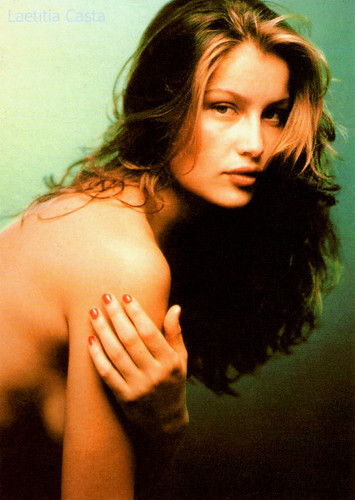
English postcard by GB Posters, Sheffield, no. PC 0144.

British postcard by Heroes Publishing LTD, London, no. SPC 3449.
Marianne
Laetitia Marie Laure Casta was born in Pont-Audemer in Normandy in 1978. She spent her childhood in Normandy and Corsica, with her mother, Line Blin, from Normandy and her father, Dominique Casta, from Corsica. She has an older brother, Jean-Baptiste, and a younger sister, Marie-Ange.
Casta's modelling career reportedly began when she was discovered by the photographer Frederic Cresseaux, an agent of Paris' Madison Models, during a family holiday in her father's native Corsica, at age 15. With her natural beauty, she impressed both the agency's director and the editor of Elle magazine and got a contract.
In 1993 Laetitia signed on with Guess? Jeans for a very successful advertising campaign. Since 1998, Casta has been the L'Oréal Paris brand ambassador. Casta has appeared on over 100 magazine covers including Victoria's Secret catalogues, Harper's Bazaar, Elle magazine, and Vogue magazine. She is the face of several fragrances, including Chanel's Allure and Givenchy's Forbidden flower. She walked down the annual Victoria's Secret Fashion Show from 1997 till 2000.
In 1999, Casta was ranked first in a national survey ordered by the French Mayors Association to decide who should be the new model for the bust of Marianne, an allegorical symbol of the French Republic, which stands inside every French town hall.
For her first film, Casta has made forays into the blockbuster Asterix & Astérix et Obélix contre César/Asterix & Obelix Take On Caesar (Claude Zidi, 1999), based on the comic book by René Goscinny. In this live-action film, she played Falbala, a love interest for Obelix ( Gérard Depardieu ). It was the most expensive French film ever made and a smash hit in Europe.
Her acting career gained momentum when she starred in the TV mini-series La bicyclette bleue/The blue bicycle (Thierry Binisti, 2000), set in WWII France.
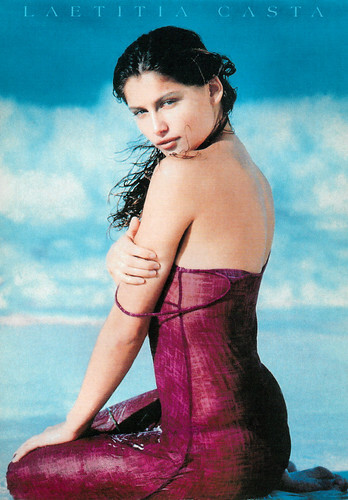
British postcard by Anabas, Essex, no. AP 752.
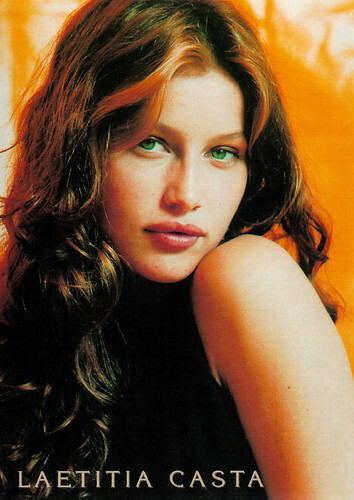
British postcard by Anabas, Essex, no. AP 753.
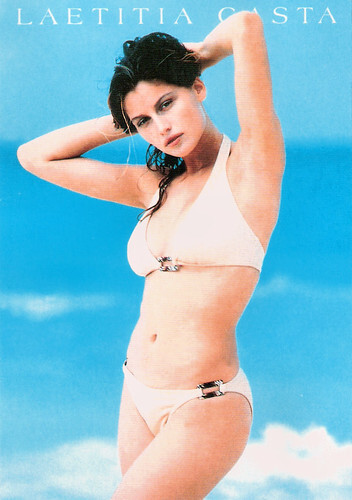
English postcard by Anabas, Essex, no. AP 754.
Brigitte Bardot
In 2001, Laetitia Casta appeared in the dramatic film Les Âmes Fortes/Savage Souls (Raoul Ruiz, 2001). It was a major disappointment.
James Travers at Films de France : “Despite an impressive cast and some excellent production values, this quality adaptation of the classic French novel by Jean Giono generally fails to engage the spectator and is amongst the least satisfactory of Raoul Ruiz's directorial efforts to date. Visually impressive this film may be - with some beautiful photography of its Provencal setting and meticulous attention to period detail - but shallow characterization and uneven narrative pacing make watching it a painfully empty experience.”
Other films are Errance/Wandering (Damien Odoul, 2003) and the TV film Luisa Sanfelice (Paolo Taviani, Vittorio Taviani, 2004).
On stage, she featured in the plays Ondine (2004-2005) written by Jean Giraudoux and Elle t'attend (She is waiting for you) (2008), written and directed by Florian Zeller.
In the cinema, she worked with interesting directors like Olivier Ducastel and Jacques Martineau for Nés en 68/Born in 68 (2008) and Tsai Ming-Liang for Visage/Face (2009).
Her interpretation of Brigitte Bardot in the film Gainsbourg (Vie héroïque)/Gainsbourg: A Heroic Life (Joann Sfar, 2010) was received well. She was nominated for the César Award of the Best Supporting Actress.
Casta served as a jury member at the 69th Venice International Film Festival in 2012. That year, she also appeared in her first American film, Arbitrage (Nicholas Jarecki, 2012) starring Richard Gere. In 2012, she also became a Chevalier dans l'Ordre des Arts et des Lettres (Knight in Order of Arts and of Letters).
Since then she appeared with Vanessa Paradis and Isabelle Adjani in Very Bad Girls (Audrey Dana, 2014), in L'Homme fidèle/A Faithful Man (Louis Garrel, 2018), and in Le Milieu de l'horizon/Beyond the Horizon (Delphine Lehericey, 2019).
Since 2017, she is married to French actor Louis Garrel. She has four children: a daughter Sahteene Sednaoui (2001) with her ex-boyfriend, the photographer Stephane Sednaoui, a son Orlando Accorsi (2006) and a daughter Athena Accorsi (2009) with ex-fiancé, the Italian actor Stefano Accorsi and a son Azel (2021) with husband Louis Garrel. Her most recent films are Coma (Bertrand Bonello, 2022) with Julia Faure and the recently deceased Gaspard Ulliel , and Selon la police/Cop goes missing (Frédéric Videau, 2022).
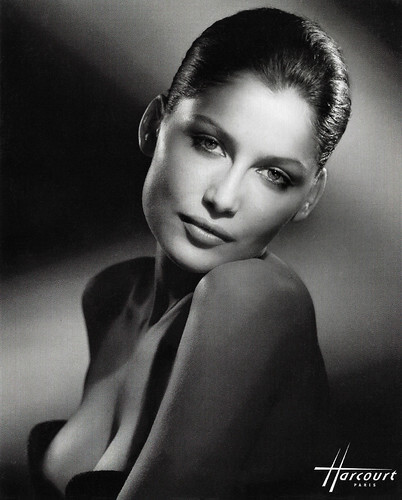
French postcard by lmp editions, no. SH 010. Photo: Studio Harcourt, Paris, 2005.
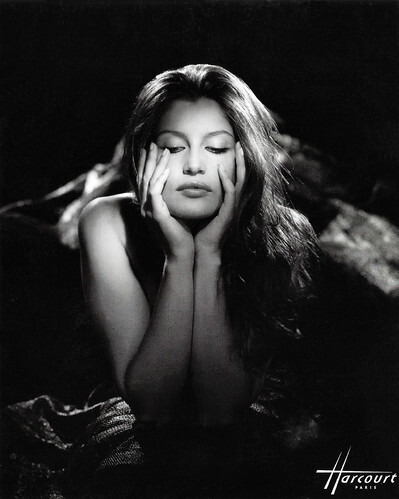
French postcard by lmp editions, no. SH 071. Photo: Studio Harcourt, Paris, 2005.
Trailer Gainsbourg (Vie héroïque)/Gainsbourg: A Heroic Life (2010). Source: icineytv (YouTube).
Sources: James Travers (Films de France), (IMDb), Wikipedia and .

French postcard by Sonis, no. C 944. Photo: Etienne George / Renn Productions. Laetitia Casta in Asterix & Astérix et Obélix contre César/Asterix & Obelix Take On Caesar (Claude Zidi, 1999).

English postcard by GB Posters, Sheffield, no. PC 0144.

British postcard by Heroes Publishing LTD, London, no. SPC 3449.
Marianne
Laetitia Marie Laure Casta was born in Pont-Audemer in Normandy in 1978. She spent her childhood in Normandy and Corsica, with her mother, Line Blin, from Normandy and her father, Dominique Casta, from Corsica. She has an older brother, Jean-Baptiste, and a younger sister, Marie-Ange.
Casta's modelling career reportedly began when she was discovered by the photographer Frederic Cresseaux, an agent of Paris' Madison Models, during a family holiday in her father's native Corsica, at age 15. With her natural beauty, she impressed both the agency's director and the editor of Elle magazine and got a contract.
In 1993 Laetitia signed on with Guess? Jeans for a very successful advertising campaign. Since 1998, Casta has been the L'Oréal Paris brand ambassador. Casta has appeared on over 100 magazine covers including Victoria's Secret catalogues, Harper's Bazaar, Elle magazine, and Vogue magazine. She is the face of several fragrances, including Chanel's Allure and Givenchy's Forbidden flower. She walked down the annual Victoria's Secret Fashion Show from 1997 till 2000.
In 1999, Casta was ranked first in a national survey ordered by the French Mayors Association to decide who should be the new model for the bust of Marianne, an allegorical symbol of the French Republic, which stands inside every French town hall.
For her first film, Casta has made forays into the blockbuster Asterix & Astérix et Obélix contre César/Asterix & Obelix Take On Caesar (Claude Zidi, 1999), based on the comic book by René Goscinny. In this live-action film, she played Falbala, a love interest for Obelix ( Gérard Depardieu ). It was the most expensive French film ever made and a smash hit in Europe.
Her acting career gained momentum when she starred in the TV mini-series La bicyclette bleue/The blue bicycle (Thierry Binisti, 2000), set in WWII France.

British postcard by Anabas, Essex, no. AP 752.

British postcard by Anabas, Essex, no. AP 753.

English postcard by Anabas, Essex, no. AP 754.
Brigitte Bardot
In 2001, Laetitia Casta appeared in the dramatic film Les Âmes Fortes/Savage Souls (Raoul Ruiz, 2001). It was a major disappointment.
James Travers at Films de France : “Despite an impressive cast and some excellent production values, this quality adaptation of the classic French novel by Jean Giono generally fails to engage the spectator and is amongst the least satisfactory of Raoul Ruiz's directorial efforts to date. Visually impressive this film may be - with some beautiful photography of its Provencal setting and meticulous attention to period detail - but shallow characterization and uneven narrative pacing make watching it a painfully empty experience.”
Other films are Errance/Wandering (Damien Odoul, 2003) and the TV film Luisa Sanfelice (Paolo Taviani, Vittorio Taviani, 2004).
On stage, she featured in the plays Ondine (2004-2005) written by Jean Giraudoux and Elle t'attend (She is waiting for you) (2008), written and directed by Florian Zeller.
In the cinema, she worked with interesting directors like Olivier Ducastel and Jacques Martineau for Nés en 68/Born in 68 (2008) and Tsai Ming-Liang for Visage/Face (2009).
Her interpretation of Brigitte Bardot in the film Gainsbourg (Vie héroïque)/Gainsbourg: A Heroic Life (Joann Sfar, 2010) was received well. She was nominated for the César Award of the Best Supporting Actress.
Casta served as a jury member at the 69th Venice International Film Festival in 2012. That year, she also appeared in her first American film, Arbitrage (Nicholas Jarecki, 2012) starring Richard Gere. In 2012, she also became a Chevalier dans l'Ordre des Arts et des Lettres (Knight in Order of Arts and of Letters).
Since then she appeared with Vanessa Paradis and Isabelle Adjani in Very Bad Girls (Audrey Dana, 2014), in L'Homme fidèle/A Faithful Man (Louis Garrel, 2018), and in Le Milieu de l'horizon/Beyond the Horizon (Delphine Lehericey, 2019).
Since 2017, she is married to French actor Louis Garrel. She has four children: a daughter Sahteene Sednaoui (2001) with her ex-boyfriend, the photographer Stephane Sednaoui, a son Orlando Accorsi (2006) and a daughter Athena Accorsi (2009) with ex-fiancé, the Italian actor Stefano Accorsi and a son Azel (2021) with husband Louis Garrel. Her most recent films are Coma (Bertrand Bonello, 2022) with Julia Faure and the recently deceased Gaspard Ulliel , and Selon la police/Cop goes missing (Frédéric Videau, 2022).

French postcard by lmp editions, no. SH 010. Photo: Studio Harcourt, Paris, 2005.

French postcard by lmp editions, no. SH 071. Photo: Studio Harcourt, Paris, 2005.
Trailer Gainsbourg (Vie héroïque)/Gainsbourg: A Heroic Life (2010). Source: icineytv (YouTube).
Sources: James Travers (Films de France), (IMDb), Wikipedia and .
Published on May 02, 2022 22:00
May 1, 2022
Written by William Shakespeare
New series alert! Today we start a series of posts on authors whose oeuvre has often adapted to the screen. More than 420 feature film versions have been produced of William Shakespeare's plays, making Shakespeare the most filmed author ever, in every language. Some versions remain fairly faithful to the original story and text, while others are rather adaptations that rely more or less loosely on the original plot and dialogue. In this post, we focus on film adaptations that stayed close to the original.
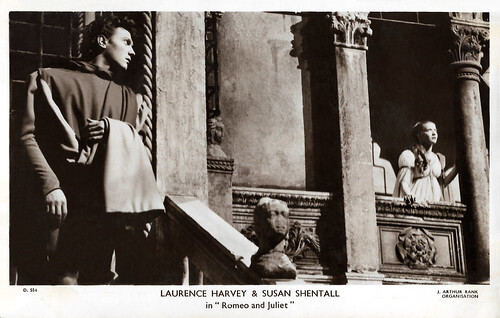
British postcard in the Picturegoer Series, London, no. D 554. Photo: J. Arthur Rank Organisation. Laurence Harvey and Susan Shentall in Romeo and Juliet (Renato Castellani, 1954).
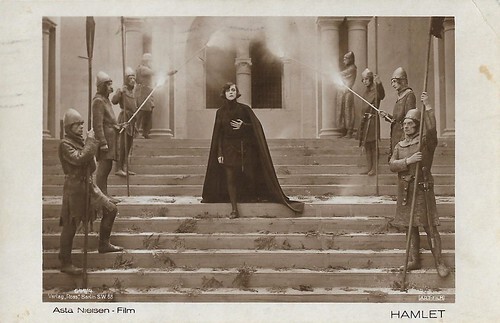
German postcard by Verlag Ross, Berlin, no. 644/4. Photo: Art-Film / Asta Nielsen-Film. Asta Nielsen as Hamlet in Hamlet (Svend Gade, Heinz Schall, 1921). Asta Nielsen had produced the film herself.
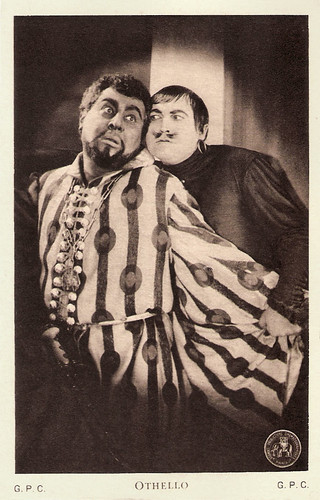
French postcard by Edition de la Cinématographie-Française, Paris. Photo: G.P.C. Emil Jannings as Othello and Werner Krauss as Jago in Othello (Dimitri Buchowetzki, 1922).
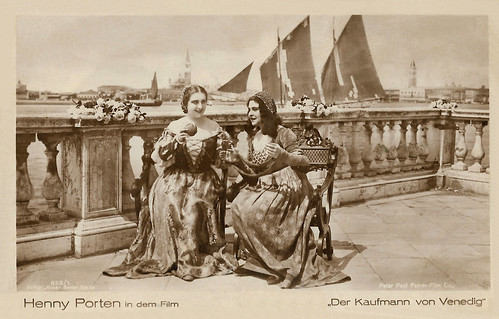
German postcard by Ross Verlag, no. 658/1. Photo: Peter Paul Felner-Film Co. Henny Porten and Lia Eibenschütz in Der Kaufmann von Venedig/The Merchant of Venice (Peter Paul Felner, 1923).
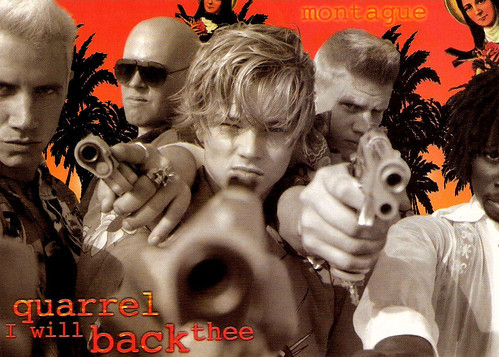
Vintage postcard. Photo: 20th Century Fox. Jamie Kennedy, Zak Orth, Leonardo DiCaprio , Dash Mihok, and Harold Perrineau in Romeo + Juliet (Baz Luhrmann, 1996). Caption: Montague. Quarrel I Will Back Thee.
A gender-bending Hamlet
In the 1900s, when the silent film industry began to develop in Europe and America, plays by Shakespeare made up a small part of the total production. The public domain status of Shakespeare's plays made them attractive to film producers, who did not have to feel bound to remain faithful to the originals.
The earliest known production is King John (1899) with Sir Herbert Beerbohm Tree by the London studio of the British Mutoscope and Biograph Company. It was a scene from Shakespeare’s 'King John' which was then on the boards at Her Majesty’s Theatre, recorded on 68-mm film. Of four excerpts shot and later exhibited at London’s Palace Theatre to promote the stage production, only the death scene (Act V, scene 2), long thought lost, resurfaced in 1990 in the archive of Eye Filmmuseum in Amsterdam.
In 1900, 'Hamlet' was filmed in France, with Sarah Bernhardt somewhat unexpectedly in the title role. Bernhardt appeared on-screen at the Paris Exposition in the duel scene from 'Hamlet'. In France and Italy at that time, the film was not considered a separate art form, but a medium to present the art of traditional theatre. This movement that cast high-profile actors in adaptations of famous plays, was given the name 'Film d'Art' in 1907.
In the United States, the film industry was initially propelled by a few thousand cheap and widespread 'nickelodeons' (cinematographs). American filmmakers then began to strive to attract the attention of the upper class as well. Possibly, they were also influenced by the 'Film d'Art' spirit. The themes of their films shifted from stories about contemporary workers to classical works.
Filmmakers also responded to demands from religious groups and authorities to reduce the amount of violence shown in historical films. Shakespeare's plays were widely respected by both the upper and lower classes of American society, and their public domain status avoided copyright issues. One of the best-known Shakespeare film studios of the time was Vitagraph in New York. Brooklyn’s Prospect Park served as one location for A Midsummer Night’s Dream (1909), and Central Park’s Bethesda Fountain doubled as a Veronese street in Romeo and Juliet (1908).
Directors Svend Gade and Heinz Schall came up with a gender-bending Hamlet (1920), which starred Asta Nielsen as a cross-dressed prince. Emil Jannings played the title role in Othello (1922) to Werner Krauss ’s Iago. Krauss also portrayed Shylock in a free adaptation of The Merchant of Venice, Der Kaufmann von Venedig (1923).
In the United States, Mary Pickford played a saucy Kate opposite Douglas Fairbanks as Petruchio in The Taming of the Shrew (1929), the first feature-length sound film of Shakespeare. With her sly wink to Bianca during the 'submission' speech to Petruchio, she showed how the film could subvert the Shakespearean text.
Warner Brothers’ A Midsummer Night’s Dream (1935), directed by émigrés Max Reinhardt and William Dieterle , revealed the influence of Weimar Expressionism, but it combined the incidental music of Felix Mendelssohn with the presence of contract actors James Cagney and Mickey Rooney , who played Bottom and Puck, respectively. Almost immediately thereafter, producer Irving Thalberg and director George Cukor offered a reverential Romeo and Juliet (1936), with Norma Shearer and Leslie Howard and a supporting cast of actors from the Hollywood expatriate British colony.
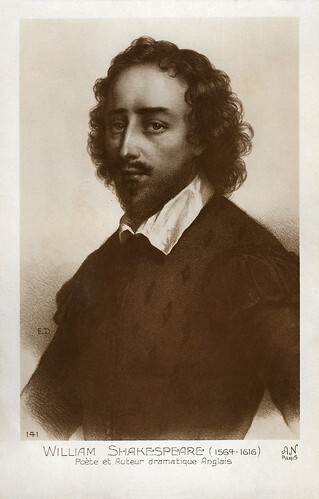
French postcard by A.N., Paris, no. 141. Image: E.D. William Shakespeare.
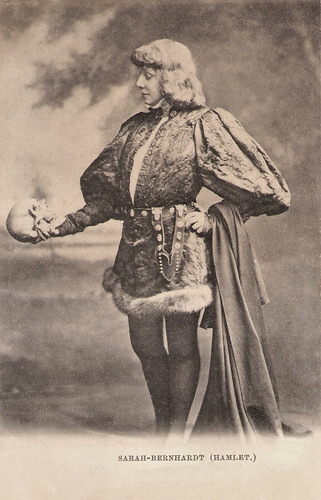
French postcard. Sarah Bernhardt in the title role of William Shakespeare's 'Hamlet' (1899).
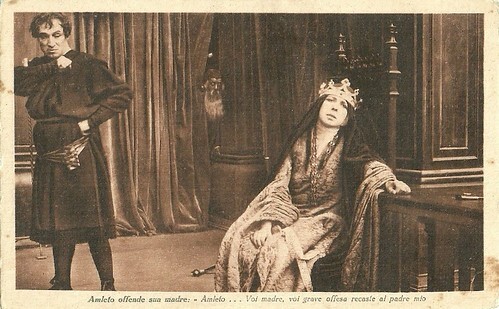
Italian postcard for the film Amleto/Hamlet (Eleuterio Rodolfi, 1917), adapted from Shakespeare's play 'Hamlet', and starring Ruggero Ruggeri in the title role, here also with Mercedes Brigone as Hamlet's mother, Queen Gertrude, while Polonius spies between the curtains. Caption: Hamlet: You mother, you committed a grave offense to my father.
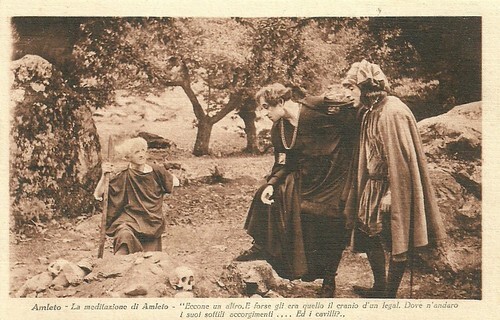
Italian postcard. Ruggero Ruggeri as Hamlet in Amleto/Hamlet (Eleuterio Rodolfi, 1917). Hamlet's meditation: 'There's another: why may not that be the skull of a lawyer? Where be his quiddities now, his quillets, his cases, his tenures, and his tricks?' (Shakespeare).
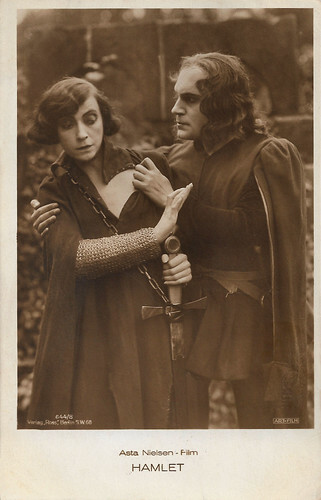
German postcard by Ross Verlag, Berlin, no. 644/8, 1919-1924. Photo: Art-Film. Asta Nielsen as Hamlet and Heinz Stieda as Horatio in Hamlet (Svend Gade, Heinz Schall, 1921).
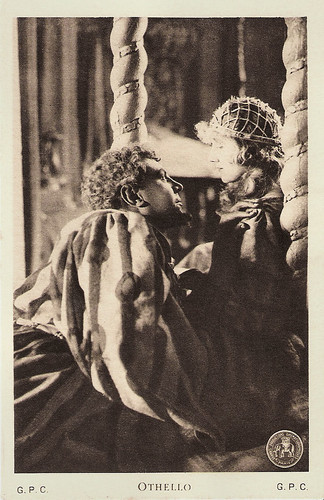
French postcard by Edition de la Cinematographie Française. Photo: Grandes Productions Cinématographiques (G.P.C.). Emil Jannings and Ica von Lenkeffy in Othello (Dimitri Buchowetzki, 1922).
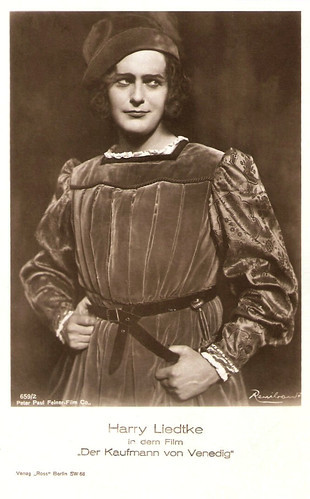
German postcard by Ross Verlag, no. 659/2, 1919-1924. Photo: Rembrandt / Peter Paul Felner Film Co. Harry Liedtke in Der Kaufmann von Venedig/The Merchant Of Venice (Peter Paul Felner, 1923).
Blowing the dust of Rome and Julia
The numerous film adaptations of 'Romeo and Juliet' (1597) show how popular, flexible, and timeless Shakespeare's oeuvre is. Kevin Toma, a critic of the Dutch newspaper De Volkskrant noted that the love tragedy has been adapted for the big screen into zombie comedy (Warm Bodies, 2013), action film (Romeo Must Die, 2000), musical (West Side Story, 1961/2021) and everything in between.
Toma: "As far as text-based film adaptations go, two stand out. Thanks to Romeo and Juliet (Franco Zeffirelli, 1968) and Romeo + Juliet (Baz Luhrmann, 1996), entire generations of filmgoers became addicted to Shakespeare's doomed lovers. Zeffirelli was the first film director to cast his protagonists more or less in the age of their characters. Juliet is 13, Romeo is probably a little older, around 17. Exactly the age of performer Leonard Whiting, while co-star Olivia Hussey was 16 during filming. The two still effortlessly draw you into the immaculate love that Romeo and Juliet feel for each other, and which they try to shield from the bloody feud in which their families find themselves. And how about a more intimate version of the nocturnal balcony scene?
Baz Luhrmann blew the dust off the play in a different way. The location of Romeo + Juliet is no longer 15th-century Verona, but the contemporary fictional town of Verona Beach, where the Capulets and Montagues make things unsafe as rival gangs of thugs. In this sandy setting, Shakespeare's verses go hand in hand with a flashy, restless style that refers as easily to spaghetti westerns as it does to the James Dean classic Rebel without a Cause (Nicholas Ray, 1955).
As far as Luhrmann was concerned, this was entirely in keeping with the Elizabethan theatre tradition of Shakespeare's time, when consistent dramatic style was frowned upon. The sombre tone of 'Romeo and Juliet' can sometimes suddenly become comic, and Luhrmann felt that a contemporary adaptation should make these changes of pace and atmosphere comprehensible to a new audience.
It is the youthful heroes, unforgettably portrayed by Leonardo DiCaprio and Claire Danes, who provide resting points with their forbidden romance: how tender, poetic and romantic it remains, the scene in which the two cast each other's distant glances on either side of an aquarium, the fish swimming between their eyes and lips."
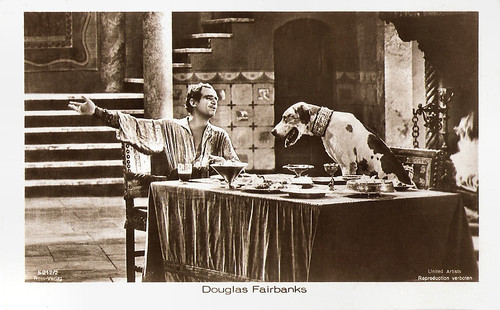
German postcard by Ross-Verlag, no. 5212/2, 1930-1931. Photo: K.O. Rahmn (Knut Olaf Rahmn) / United Artists. Douglas Fairbanks in The Taming of the Shrew (Sam Taylor, 1930).
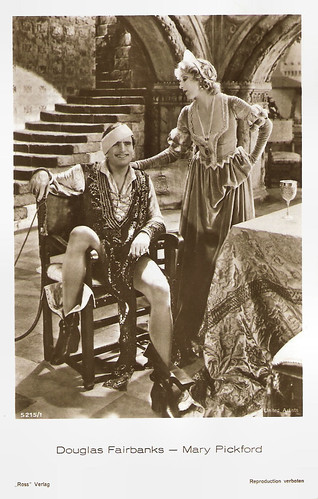
German postcard by Ross-Verlag, no. 5215/1 1930-1931. Photo: K.O. Rahmn (Knut Olaf Rahmn) / United Artists. Douglas Fairbanks and Mary Pickford in The Taming of the Shrew (Sam Taylor, 1930).
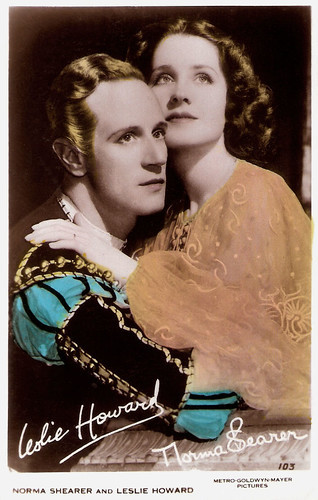
British postcard by Real Photograph, no. 103. Photo: Metro-Goldwyn-Mayer Pictures. Leslie Howard and Norma Shearer in Romeo and Juliet (George Cukor, 1936).
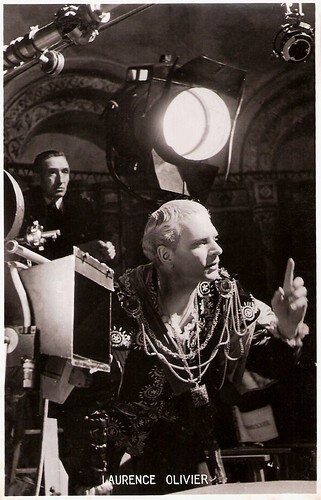
British postcard by Rotary Photo, London, nr. F.S.5. Photo: Laurence Olivier directs a scene in Hamlet (1948).
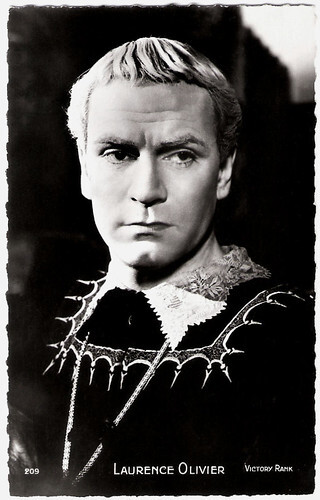
French postcard by Editions P.I., Paris, no. 209. Photo: Victory Rank. Laurence Olivier in Hamlet (Laurence Olivier, 1948).
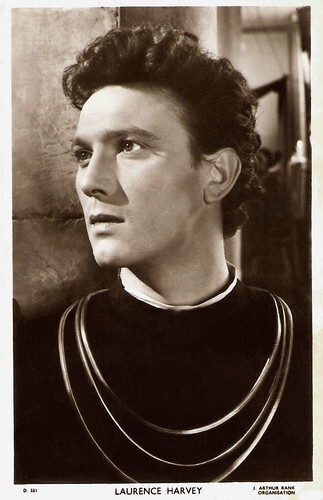
British postcard in the Picturegoer Series, London, no. D 551. Photo: J. Arthur Rank Organisation. Laurence Harvey as Romeo in Romeo and Juliet (Renato Castellani, 1954).
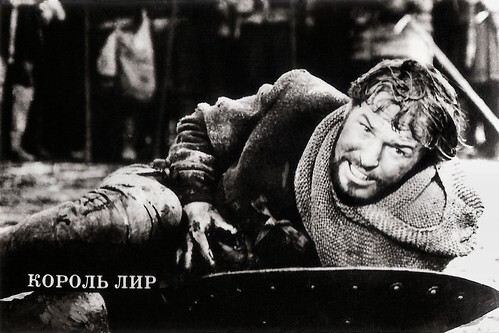
Soviet collectors card. Photo: Regimantas Adomaitis in Korol Lir/King Lear (Grigori Kozintsev, Iosif Shapiro, 1971).
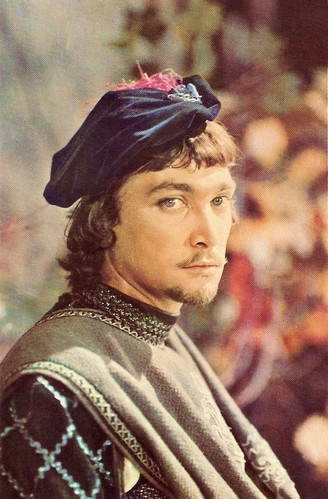
Soviet postcard by Izdanije Byuro Propogandy Sovietskogo Kinoiskusstva. This postcard was printed in an edition of 200.000 cards. The price was 5 kop. Vladimir Korenev in Mnogo shuma iz nichego/Much Ado About Nothing (Samson Samsonov, 1973).
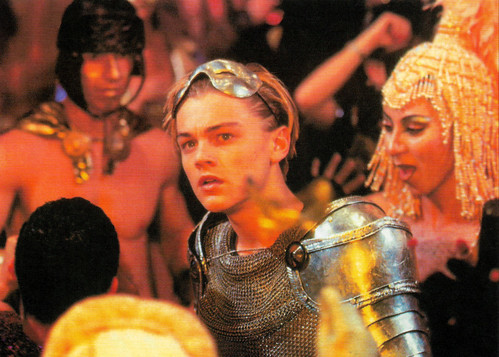
Vintage postcard. Leonardo DiCaprio in Romeo + Juliet (Baz Luhrmann, 1996).
Sources: Kevin Toma (De Volkskrant - Dutch), Kenneth S. Rothwell (Encyclopaedia Britannica), and Wikipedia (Dutch.)

British postcard in the Picturegoer Series, London, no. D 554. Photo: J. Arthur Rank Organisation. Laurence Harvey and Susan Shentall in Romeo and Juliet (Renato Castellani, 1954).

German postcard by Verlag Ross, Berlin, no. 644/4. Photo: Art-Film / Asta Nielsen-Film. Asta Nielsen as Hamlet in Hamlet (Svend Gade, Heinz Schall, 1921). Asta Nielsen had produced the film herself.

French postcard by Edition de la Cinématographie-Française, Paris. Photo: G.P.C. Emil Jannings as Othello and Werner Krauss as Jago in Othello (Dimitri Buchowetzki, 1922).

German postcard by Ross Verlag, no. 658/1. Photo: Peter Paul Felner-Film Co. Henny Porten and Lia Eibenschütz in Der Kaufmann von Venedig/The Merchant of Venice (Peter Paul Felner, 1923).

Vintage postcard. Photo: 20th Century Fox. Jamie Kennedy, Zak Orth, Leonardo DiCaprio , Dash Mihok, and Harold Perrineau in Romeo + Juliet (Baz Luhrmann, 1996). Caption: Montague. Quarrel I Will Back Thee.
A gender-bending Hamlet
In the 1900s, when the silent film industry began to develop in Europe and America, plays by Shakespeare made up a small part of the total production. The public domain status of Shakespeare's plays made them attractive to film producers, who did not have to feel bound to remain faithful to the originals.
The earliest known production is King John (1899) with Sir Herbert Beerbohm Tree by the London studio of the British Mutoscope and Biograph Company. It was a scene from Shakespeare’s 'King John' which was then on the boards at Her Majesty’s Theatre, recorded on 68-mm film. Of four excerpts shot and later exhibited at London’s Palace Theatre to promote the stage production, only the death scene (Act V, scene 2), long thought lost, resurfaced in 1990 in the archive of Eye Filmmuseum in Amsterdam.
In 1900, 'Hamlet' was filmed in France, with Sarah Bernhardt somewhat unexpectedly in the title role. Bernhardt appeared on-screen at the Paris Exposition in the duel scene from 'Hamlet'. In France and Italy at that time, the film was not considered a separate art form, but a medium to present the art of traditional theatre. This movement that cast high-profile actors in adaptations of famous plays, was given the name 'Film d'Art' in 1907.
In the United States, the film industry was initially propelled by a few thousand cheap and widespread 'nickelodeons' (cinematographs). American filmmakers then began to strive to attract the attention of the upper class as well. Possibly, they were also influenced by the 'Film d'Art' spirit. The themes of their films shifted from stories about contemporary workers to classical works.
Filmmakers also responded to demands from religious groups and authorities to reduce the amount of violence shown in historical films. Shakespeare's plays were widely respected by both the upper and lower classes of American society, and their public domain status avoided copyright issues. One of the best-known Shakespeare film studios of the time was Vitagraph in New York. Brooklyn’s Prospect Park served as one location for A Midsummer Night’s Dream (1909), and Central Park’s Bethesda Fountain doubled as a Veronese street in Romeo and Juliet (1908).
Directors Svend Gade and Heinz Schall came up with a gender-bending Hamlet (1920), which starred Asta Nielsen as a cross-dressed prince. Emil Jannings played the title role in Othello (1922) to Werner Krauss ’s Iago. Krauss also portrayed Shylock in a free adaptation of The Merchant of Venice, Der Kaufmann von Venedig (1923).
In the United States, Mary Pickford played a saucy Kate opposite Douglas Fairbanks as Petruchio in The Taming of the Shrew (1929), the first feature-length sound film of Shakespeare. With her sly wink to Bianca during the 'submission' speech to Petruchio, she showed how the film could subvert the Shakespearean text.
Warner Brothers’ A Midsummer Night’s Dream (1935), directed by émigrés Max Reinhardt and William Dieterle , revealed the influence of Weimar Expressionism, but it combined the incidental music of Felix Mendelssohn with the presence of contract actors James Cagney and Mickey Rooney , who played Bottom and Puck, respectively. Almost immediately thereafter, producer Irving Thalberg and director George Cukor offered a reverential Romeo and Juliet (1936), with Norma Shearer and Leslie Howard and a supporting cast of actors from the Hollywood expatriate British colony.

French postcard by A.N., Paris, no. 141. Image: E.D. William Shakespeare.

French postcard. Sarah Bernhardt in the title role of William Shakespeare's 'Hamlet' (1899).

Italian postcard for the film Amleto/Hamlet (Eleuterio Rodolfi, 1917), adapted from Shakespeare's play 'Hamlet', and starring Ruggero Ruggeri in the title role, here also with Mercedes Brigone as Hamlet's mother, Queen Gertrude, while Polonius spies between the curtains. Caption: Hamlet: You mother, you committed a grave offense to my father.

Italian postcard. Ruggero Ruggeri as Hamlet in Amleto/Hamlet (Eleuterio Rodolfi, 1917). Hamlet's meditation: 'There's another: why may not that be the skull of a lawyer? Where be his quiddities now, his quillets, his cases, his tenures, and his tricks?' (Shakespeare).

German postcard by Ross Verlag, Berlin, no. 644/8, 1919-1924. Photo: Art-Film. Asta Nielsen as Hamlet and Heinz Stieda as Horatio in Hamlet (Svend Gade, Heinz Schall, 1921).

French postcard by Edition de la Cinematographie Française. Photo: Grandes Productions Cinématographiques (G.P.C.). Emil Jannings and Ica von Lenkeffy in Othello (Dimitri Buchowetzki, 1922).

German postcard by Ross Verlag, no. 659/2, 1919-1924. Photo: Rembrandt / Peter Paul Felner Film Co. Harry Liedtke in Der Kaufmann von Venedig/The Merchant Of Venice (Peter Paul Felner, 1923).
Blowing the dust of Rome and Julia
The numerous film adaptations of 'Romeo and Juliet' (1597) show how popular, flexible, and timeless Shakespeare's oeuvre is. Kevin Toma, a critic of the Dutch newspaper De Volkskrant noted that the love tragedy has been adapted for the big screen into zombie comedy (Warm Bodies, 2013), action film (Romeo Must Die, 2000), musical (West Side Story, 1961/2021) and everything in between.
Toma: "As far as text-based film adaptations go, two stand out. Thanks to Romeo and Juliet (Franco Zeffirelli, 1968) and Romeo + Juliet (Baz Luhrmann, 1996), entire generations of filmgoers became addicted to Shakespeare's doomed lovers. Zeffirelli was the first film director to cast his protagonists more or less in the age of their characters. Juliet is 13, Romeo is probably a little older, around 17. Exactly the age of performer Leonard Whiting, while co-star Olivia Hussey was 16 during filming. The two still effortlessly draw you into the immaculate love that Romeo and Juliet feel for each other, and which they try to shield from the bloody feud in which their families find themselves. And how about a more intimate version of the nocturnal balcony scene?
Baz Luhrmann blew the dust off the play in a different way. The location of Romeo + Juliet is no longer 15th-century Verona, but the contemporary fictional town of Verona Beach, where the Capulets and Montagues make things unsafe as rival gangs of thugs. In this sandy setting, Shakespeare's verses go hand in hand with a flashy, restless style that refers as easily to spaghetti westerns as it does to the James Dean classic Rebel without a Cause (Nicholas Ray, 1955).
As far as Luhrmann was concerned, this was entirely in keeping with the Elizabethan theatre tradition of Shakespeare's time, when consistent dramatic style was frowned upon. The sombre tone of 'Romeo and Juliet' can sometimes suddenly become comic, and Luhrmann felt that a contemporary adaptation should make these changes of pace and atmosphere comprehensible to a new audience.
It is the youthful heroes, unforgettably portrayed by Leonardo DiCaprio and Claire Danes, who provide resting points with their forbidden romance: how tender, poetic and romantic it remains, the scene in which the two cast each other's distant glances on either side of an aquarium, the fish swimming between their eyes and lips."

German postcard by Ross-Verlag, no. 5212/2, 1930-1931. Photo: K.O. Rahmn (Knut Olaf Rahmn) / United Artists. Douglas Fairbanks in The Taming of the Shrew (Sam Taylor, 1930).

German postcard by Ross-Verlag, no. 5215/1 1930-1931. Photo: K.O. Rahmn (Knut Olaf Rahmn) / United Artists. Douglas Fairbanks and Mary Pickford in The Taming of the Shrew (Sam Taylor, 1930).

British postcard by Real Photograph, no. 103. Photo: Metro-Goldwyn-Mayer Pictures. Leslie Howard and Norma Shearer in Romeo and Juliet (George Cukor, 1936).

British postcard by Rotary Photo, London, nr. F.S.5. Photo: Laurence Olivier directs a scene in Hamlet (1948).

French postcard by Editions P.I., Paris, no. 209. Photo: Victory Rank. Laurence Olivier in Hamlet (Laurence Olivier, 1948).

British postcard in the Picturegoer Series, London, no. D 551. Photo: J. Arthur Rank Organisation. Laurence Harvey as Romeo in Romeo and Juliet (Renato Castellani, 1954).

Soviet collectors card. Photo: Regimantas Adomaitis in Korol Lir/King Lear (Grigori Kozintsev, Iosif Shapiro, 1971).

Soviet postcard by Izdanije Byuro Propogandy Sovietskogo Kinoiskusstva. This postcard was printed in an edition of 200.000 cards. The price was 5 kop. Vladimir Korenev in Mnogo shuma iz nichego/Much Ado About Nothing (Samson Samsonov, 1973).

Vintage postcard. Leonardo DiCaprio in Romeo + Juliet (Baz Luhrmann, 1996).
Sources: Kevin Toma (De Volkskrant - Dutch), Kenneth S. Rothwell (Encyclopaedia Britannica), and Wikipedia (Dutch.)
Published on May 01, 2022 22:00
April 30, 2022
Published by Hercules
The Dutch publisher Hercules from the city of Haarlem issued in the 1960s "real" photocards in the genres film, music, and TV. These are mainly black and white pictures of film stars, who were not connected to a certain film. However, with a little detective work, we could link some of the cards to a foreign film. For this post, we selected 15 Hercules postcards.
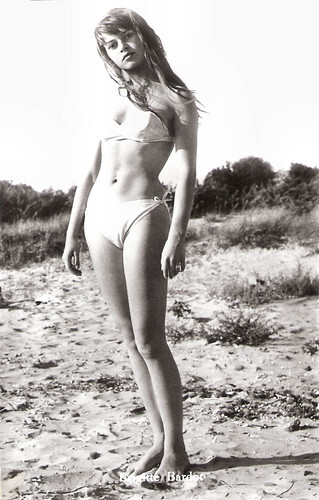
Dutch postcard by Hercules, Haarlem, no. 20. Brigitte Bardot in Manina, la fille sans voiles/The Girl in the Bikini (Willy Rozier, 1952).
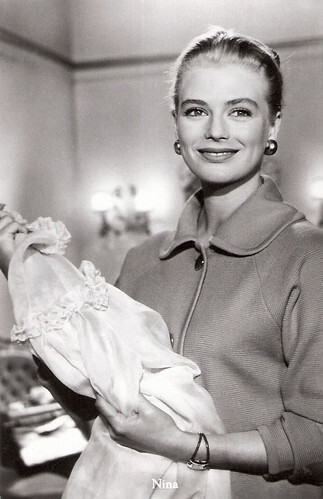
Dutch postcard by Hercules, Haarlem, no. 245. Photo: Gofilex. Nina van Pallandt in Mandolinen und Mondschein/Mandolins and Moonlight (Hans Deppe, 1959). Danish Nina van Pallandt (1932) formed with her husband Frederik the singing duo Nina & Frederik , which was very popular in Europe during the late 1950s and the 1960s. They scored many international hits and also acted in several films together. After the couple split up in 1969, Nina had a solo career as a singer and Hollywood actress.
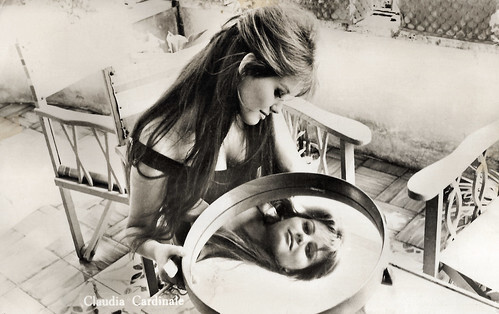
Dutch postcard by Hercules, Haarlem, no. 262. Italian actress Claudia Cardinale (1938) is one of Europe's iconic and most versatile film stars. The combination of her beauty, dark, flashing eyes, explosive sexuality, and genuine acting talent virtually guaranteed her stardom.
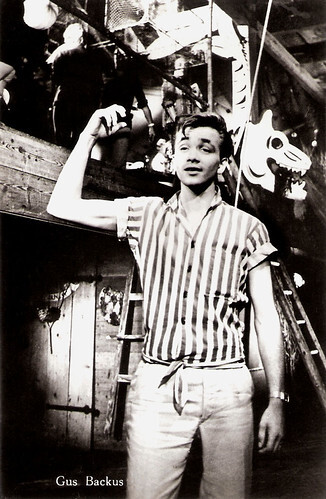
Dutch postcard by Hercules, Haarlem, no. 262. American Singer and actor Gus Backus (1937-2019) was at 19 a member of the Del-Vikings, and later became virtually the flesh-and-blood embodiment of rock and roll in Germany. Between 1959 and 1965 he also appeared in 25 German light entertainment films.

Dutch postcard by Hercules, Haarlem, no. 279. Photo: Hafbofilm. Sabine Sinjen and Corny Collins in Schmutziger Engel/Imperfect Angel (Alfred Vohrer, 1958).
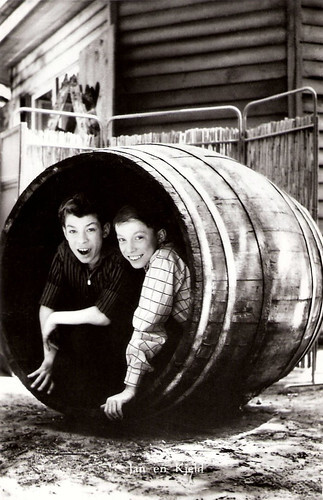
Dutch postcard by Hercules, Haarlem, no. 370. Photo: Hafbo film. Jan & Kjeld in Marina (Paul Martin, 1960).
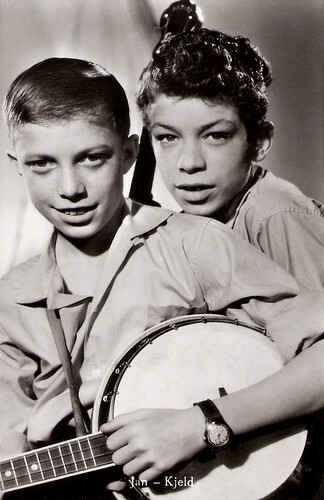
Dutch postcard by Hercules, Haarlem, no. 399. Jan & Kjeld Wennick were only 14 and 16 years old when they hit it big with the classic song 'Banjo Boy'. In the early 1960s, the two brothers from Copenhagen performed their hits in several Schlagerfilms.
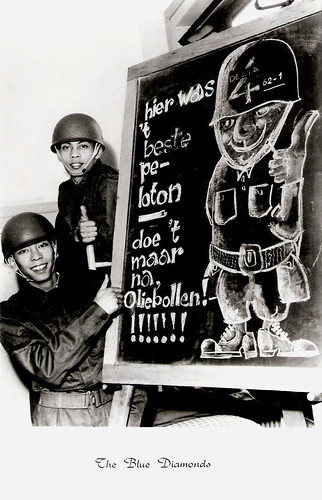
Dutch postcard by Hercules, Haarlem, no. 662. The Blue Diamonds is one of the most successful Dutch pop acts ever. Incidentally the Dutch-Indonesian brothers Ruud and Riem de Wolff also acted in films and on TV.
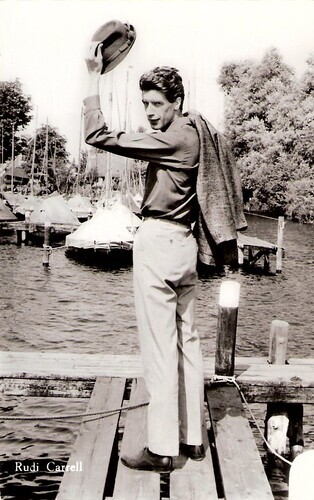
Dutch postcard by Hercules, Haarlem, no. 852. Dutch television TV host, actor, and singer Rudi Carrell (1934-2006) was hailed after his death as the greatest TV entertainer in Europe. After his breakthrough in the Netherlands, he went to Germany and gained enormous popularity there on TV. He was the first presenter to attract a TV audience of 20 million Germans, one-quarter of the total population.
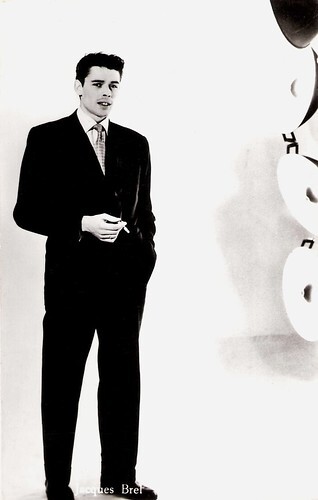
Dutch postcard by Hercules, Haarlem, no. 862. Legendary Belgian singer-songwriter Jacques Brel (1929-1978) was one of the most important and influential representatives of the French chanson.
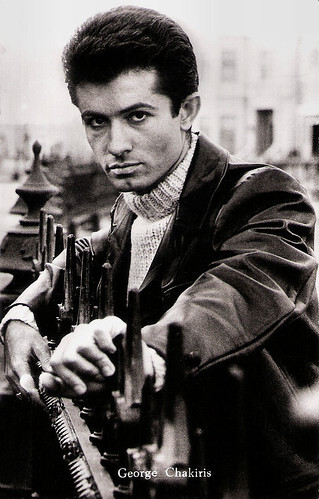
Dutch postcard by Hercules, Haarlem, no. 946. Photo: Capitol. George Chakiris on a publicity still for West Side Story (Robert Wise, 1961).
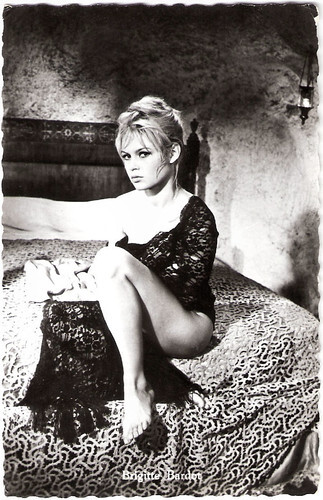
Dutch postcard by Hercules, Haarlem, no. 1069. Photo: Brigitte Bardot in Les bijoutiers du clair de lune/The Night Heaven Fell (Roger Vadim, 1958).
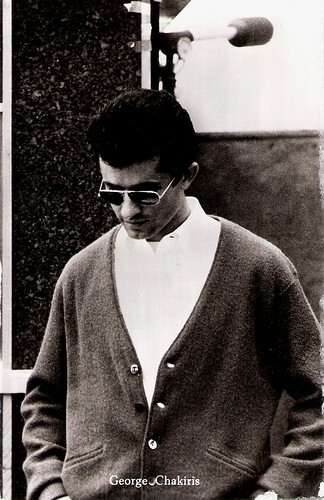
Dutch postcard by Hercules, Haarlem, no. 1089. Photo: Capitol. American dancer, singer, and actor George Chakiris (1934) had his biggest success as Bernardo, the leader of the Sharks gang in the celebrated film musical West Side Story (1961). Later he starred with Catherine Deneuve in another classic, the charming French musical Les Demoiselles de Rochefort (1967).
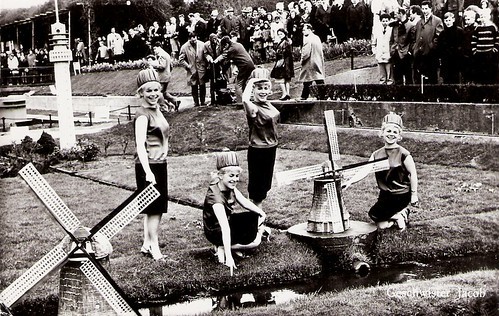
Dutch postcard by Hercules, Haarlem, no. 1350 A. Photo: CBS. The Geschwister Jacob during a promotional visit to the Netherlands in the miniature town Madurodam in The Haghe. The Geschwister Jacob or Jacob Sisters was a group of four, later three German sisters who sang Schlager songs and appeared in a few films.
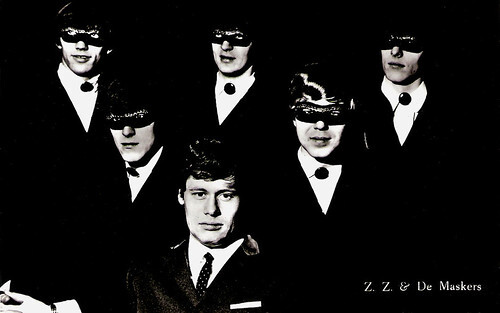
Dutch postcard by Hercules, Haarlem, no. 1370. Photo: Artone Grammofoonplaten. Dutch pop group Z. Z. & De Maskers (ZZ and the Masks) was a 1960s beat band from Amsterdam. The singer and founder was Bob Bouber, who is at centre of the postcard. He was one of the pioneers in Dutch pop culture and was the grandson of film actress Aaf Bouber.
Source: Lodewijk van Duuren (VDP).

Dutch postcard by Hercules, Haarlem, no. 20. Brigitte Bardot in Manina, la fille sans voiles/The Girl in the Bikini (Willy Rozier, 1952).

Dutch postcard by Hercules, Haarlem, no. 245. Photo: Gofilex. Nina van Pallandt in Mandolinen und Mondschein/Mandolins and Moonlight (Hans Deppe, 1959). Danish Nina van Pallandt (1932) formed with her husband Frederik the singing duo Nina & Frederik , which was very popular in Europe during the late 1950s and the 1960s. They scored many international hits and also acted in several films together. After the couple split up in 1969, Nina had a solo career as a singer and Hollywood actress.

Dutch postcard by Hercules, Haarlem, no. 262. Italian actress Claudia Cardinale (1938) is one of Europe's iconic and most versatile film stars. The combination of her beauty, dark, flashing eyes, explosive sexuality, and genuine acting talent virtually guaranteed her stardom.

Dutch postcard by Hercules, Haarlem, no. 262. American Singer and actor Gus Backus (1937-2019) was at 19 a member of the Del-Vikings, and later became virtually the flesh-and-blood embodiment of rock and roll in Germany. Between 1959 and 1965 he also appeared in 25 German light entertainment films.

Dutch postcard by Hercules, Haarlem, no. 279. Photo: Hafbofilm. Sabine Sinjen and Corny Collins in Schmutziger Engel/Imperfect Angel (Alfred Vohrer, 1958).

Dutch postcard by Hercules, Haarlem, no. 370. Photo: Hafbo film. Jan & Kjeld in Marina (Paul Martin, 1960).

Dutch postcard by Hercules, Haarlem, no. 399. Jan & Kjeld Wennick were only 14 and 16 years old when they hit it big with the classic song 'Banjo Boy'. In the early 1960s, the two brothers from Copenhagen performed their hits in several Schlagerfilms.

Dutch postcard by Hercules, Haarlem, no. 662. The Blue Diamonds is one of the most successful Dutch pop acts ever. Incidentally the Dutch-Indonesian brothers Ruud and Riem de Wolff also acted in films and on TV.

Dutch postcard by Hercules, Haarlem, no. 852. Dutch television TV host, actor, and singer Rudi Carrell (1934-2006) was hailed after his death as the greatest TV entertainer in Europe. After his breakthrough in the Netherlands, he went to Germany and gained enormous popularity there on TV. He was the first presenter to attract a TV audience of 20 million Germans, one-quarter of the total population.

Dutch postcard by Hercules, Haarlem, no. 862. Legendary Belgian singer-songwriter Jacques Brel (1929-1978) was one of the most important and influential representatives of the French chanson.

Dutch postcard by Hercules, Haarlem, no. 946. Photo: Capitol. George Chakiris on a publicity still for West Side Story (Robert Wise, 1961).

Dutch postcard by Hercules, Haarlem, no. 1069. Photo: Brigitte Bardot in Les bijoutiers du clair de lune/The Night Heaven Fell (Roger Vadim, 1958).

Dutch postcard by Hercules, Haarlem, no. 1089. Photo: Capitol. American dancer, singer, and actor George Chakiris (1934) had his biggest success as Bernardo, the leader of the Sharks gang in the celebrated film musical West Side Story (1961). Later he starred with Catherine Deneuve in another classic, the charming French musical Les Demoiselles de Rochefort (1967).

Dutch postcard by Hercules, Haarlem, no. 1350 A. Photo: CBS. The Geschwister Jacob during a promotional visit to the Netherlands in the miniature town Madurodam in The Haghe. The Geschwister Jacob or Jacob Sisters was a group of four, later three German sisters who sang Schlager songs and appeared in a few films.

Dutch postcard by Hercules, Haarlem, no. 1370. Photo: Artone Grammofoonplaten. Dutch pop group Z. Z. & De Maskers (ZZ and the Masks) was a 1960s beat band from Amsterdam. The singer and founder was Bob Bouber, who is at centre of the postcard. He was one of the pioneers in Dutch pop culture and was the grandson of film actress Aaf Bouber.
Source: Lodewijk van Duuren (VDP).
Published on April 30, 2022 22:00
April 29, 2022
Mephisto
Mephisto (also known by the names Mephistopheles, Mephistophilus, Mephistophilis, Mephistopheles, and other variants) is one of the best-known demons in European literary, theatre, and cinema tradition. The name is primarily associated with the legend of Faust. The name, or its variations, has been used extensively in literature, plays, films, music, and games. In the cinema, Emil Jannings played the best-known Mephisto in F.W. Murnau's silent classic Faust. Although the name Mephisto does not always refer to the Mephistopheles figure in the Faust legend, it does usually refer to a 'devilish' character. EFSP dedicates today's post to hell and its devils.
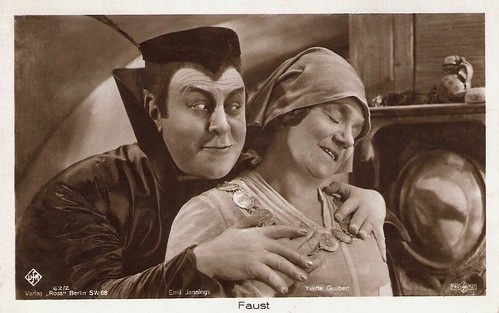
German postcard by Ross Verlag, no. 62/2. Photo: Parufamet / Ufa. Emil Jannings as Mephisto and Yvette Guilbert as Marthe in Faust (Friedrich Wilhelm Murnau, 1926).
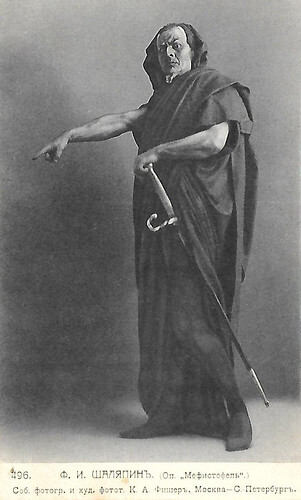
Russian postcard, no. 496. Photo: Feodor Chaliapin as Mephisto in a stage production of Arrigo Boito's opera 'Mefistofele'. Collection: Didier Hanson.
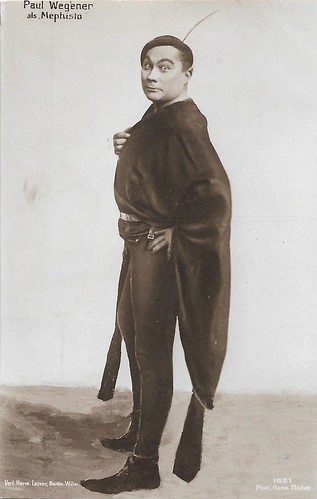
German postcard by Verlag Hermann Leiser, no. 1621. Photo: Hans Böhm. Caption: Paul Wegener as Mephisto.
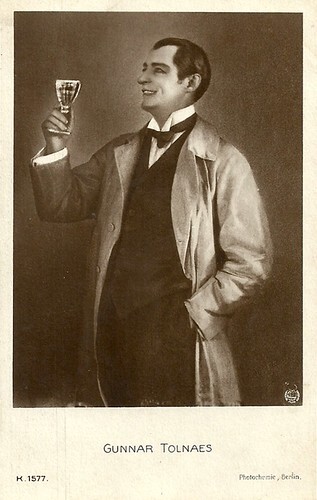
German postcard by Photochemie, no. K.1577. Photo: Nordisk Films Compagni. Gunnar Tolnaes as Doktor Voluntas a.k.as. Mephisto in Doktor X/Doktor Voluntas/The Master Physician (Robert Dinesen, 1915). This image is a variation on a film still, in which background and extras from the still are removed. See Dansk Film Institut, photo no. 4. The film was the debut of Gunnar Tolnaes at Nordisk and on the silent screen in general.
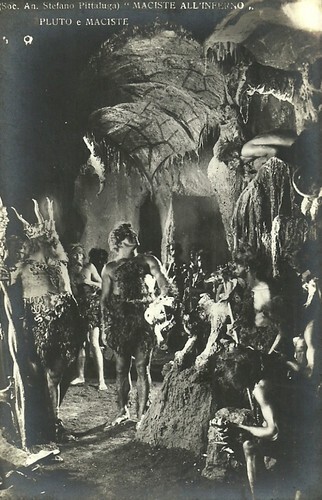
Italian postcard. Ed. A. Traldi, Milano. Photo: Bartolomeo Pagano as Maciste in the centre in the Italian silent film Maciste all'inferno/Maciste in Hell (Guido Brignone 1926). The man left with the crown is Umberto Guarracino as Pluto, King of Hell.
Faust
The name Mephistophiles is already mentioned in 'Praxis Magia Faustiana', printed in Passau in 1527, and in the anonymous 'Faustbuch' from 1587. Mephistopheles also appears as a character in several collections of stories about Faust published from the late 16th century onwards.
There has been much speculation about the meaning of the name. In Greek mē "not", phōs "light" and philos "lover" the name can be understood as "he who shuns the light", a parody of the name of Lucifer. A connection has also been made with the Hebrew mephistoph, "destroyer of good", and Mephitis was the goddess of stench in Ancient Greece.
Johann Wolfgang Goethe is said to have read a version from 1725, which inspired him to write his world-famous book 'Faust, Eine Tragödie' (Urfaust, Faust I, Faust II). As the antagonist in Goethe's Faust tragedy, Mephisto tries to make a bet with God. He says that he will succeed in dissuading Doctor Heinrich Faust from the right path. According to a subsequent agreement with Faust himself, this would be achieved if Faust found a moment so beautiful that he wanted to hold on to it permanently.
Mephisto's central role in Goethe's book certainly contributed to his enduring fame, but there were more famous writers who mentioned Mephistopheles in their work. For example, Christopher Marlowe's play 'The Tragical History of Doctor Faustus' was published in 1604, in which a demonic character named Mephistophilis appears before Faust.
The novel 'Mephisto' by Klaus Mann, published in 1936 in exile, tells the story of the actor Hendrik Höfgen (based on Gustaf Gründgens ), who comes to terms with those in power during the National Socialist era. The role of Mephisto in Goethe's 'Faust' is one of Höfgen's (like Gründgens') parade roles. In 1981, the novel was filmed by István Szabó with Klaus Maria Brandauer in the leading role. The film was the first Hungarian film to win an Academy Award for Best Foreign Film.
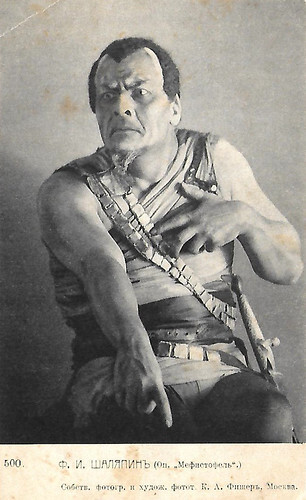
Russian postcard, no. 500. Photo: K. Fisher. Feodor Chaliapin as Mephisto in a stage production of Arrigo Boito's opera 'Mefistofele'. Collection: Didier Hanson.
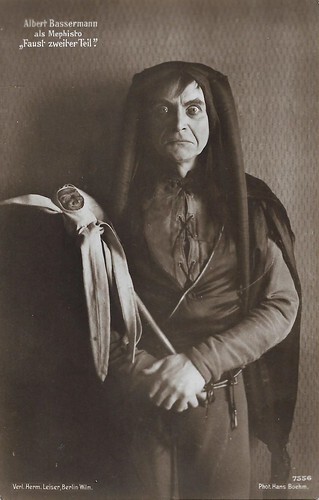
German postcard= by Verlag Hermann Leiser, Berlin, no. 7556. Photo: Hans Boehm. Albert Bassermann as Mephisto in Goethe's 'Faust, part II'. Bassermann performed in 'Faust, part 2', at the Deutsches Theater in 1911, opposite Friedrich Kayssler as Faust. He would reprise the part several times, e.g. in 1925 at the Deutsches Volkstheater, and later on in exile in the US too.
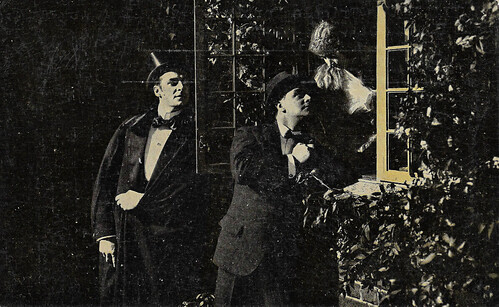
Spanish postcard by Edics. y Publics de Arte L. Planas, Barcelona. no 2. Photo: Nordisk. Gunnar Tolnaes and Carlo Wieth in Doktor X/Doktor Voluntas/The master physician (Robert Dinesen, 1915). In this modernised Faustian tale, taking place in the world of scientists, hard-working Dr. Felix ( Carlo Wieth ) is on the verge of discovering a cure to cancer, but he is deluded in life and lonesome. His stylish, elegant, and vicious colleague, Dr. Voluntas ( Gunnar Tolnaes ), offers him wealth and the woman of his dreams, Margaret (Johanne Fritz-Petersen). Dr. Felix gives in to the temptations but is struck by all kinds of misfortune. Felix battles in a duel with Margaret's brother and kills him, with the help of Voluntas. Margaret and her newborn child die in hospital. Voluntas steals Felix's research and is glorified as the inventor of the cure of cancer. Felix finally takes his own life. Doctor Voluntas stands laughing at him, dressed as Mephisto. The film justifies it by wearing a carnival costume but leaves the viewer with little doubt about his true satanic nature. On this card, Voluntas is presented as "Dr. Mefistofeles", leaving little doubt about who he is.
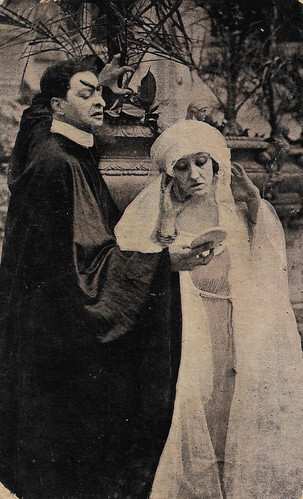
Spanish collectors card by Chocolate Pi, Barcelona, no. 1 of 6 cards. Photo: Cines / J. Muntañola. Lyda Borelli and Ugo Bazzini in Rapsodia satanica (Nino Oxilia, 1917).
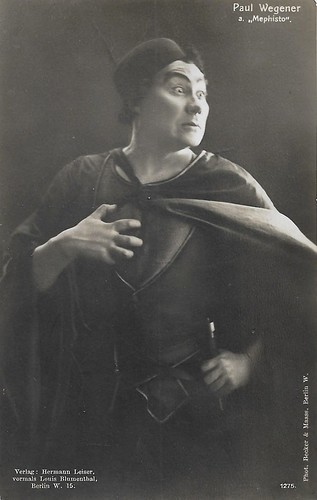
German postcard by Verlag Hermann Leiser (once Louis Blumenthal), Berlin, no. 1275. Photo: Becker & Maass, Berlin. Caption: Paul Wegener as Mephisto.
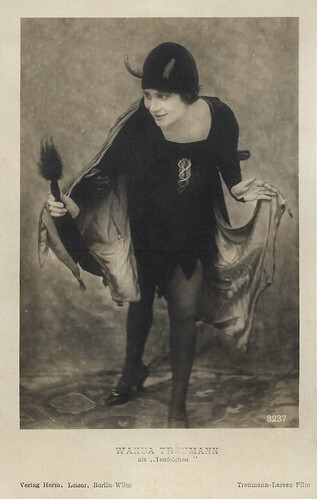
German postcard by Verlag Herm. Leiser, Berlin-Wilm., no. 3237. Wanda Treumann in Das Teufelchen/The little devil (Rosa Porten, 1917).
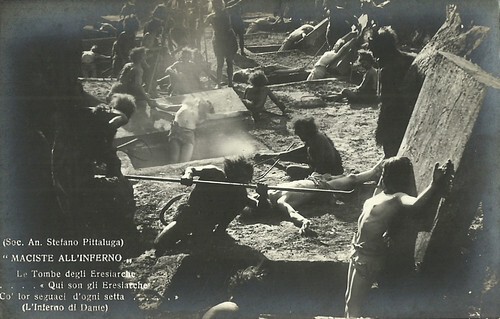
Italian postcard. Ed. A. Traldi, Milano. Photo: Pittaluga Films, Torino. Hell as envinsioned in the Italian silent film Maciste all'inferno/Maciste in Hell (Guido Brignone 1926), starring Bartolomeo Pagano as Maciste. Caption: The Tomb of the Heresiarchs [heretics].
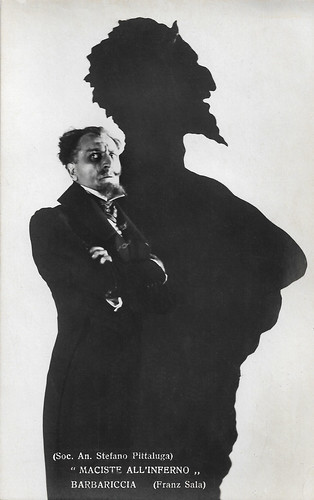
Italian postcard by Ed. A. Traldi, Milano. Franz Sala in Maciste all’inferno/Maciste in Hell (Guido Brigone, 1926).
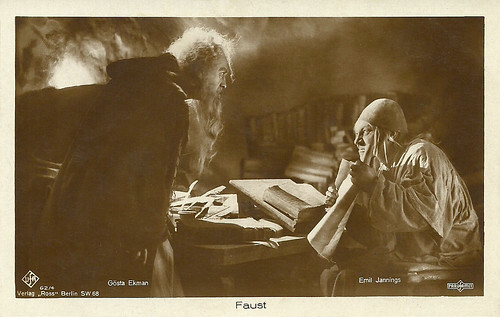
German postcard by Ross Verlag, no. 62/4. Photo: ParUfaMet / Ufa. Gösta Ekman and Emil Jannings in Faust (1926). Collection: Didier Hanson.
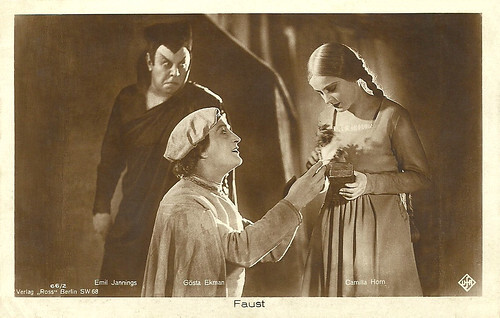
German postcard by Ross Verlag, no. 66/2. Photo: Ufa. Gösta Ekman , Emil Jannings and Camilla Horn in Faust (1926). Collection: Didier Hanson.
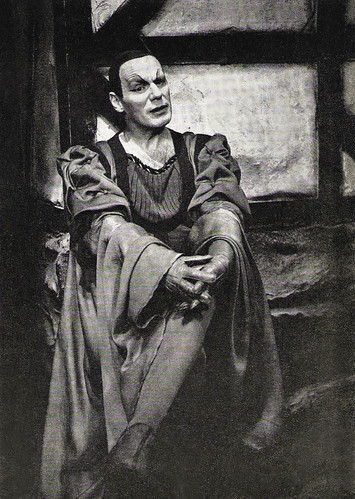
West-German postcard by Theater Heute und Opernwelt. Photo: Lieselotte Strelow. Gustaf Gründgens as Mephisto in Faust I (Peter Gorski, 1960), based on the play by Johann Wolfgang Goethe.
Sources: Wikipedia (Dutch and German), Det Danske Filminstitut (Danish), and IMDb.

German postcard by Ross Verlag, no. 62/2. Photo: Parufamet / Ufa. Emil Jannings as Mephisto and Yvette Guilbert as Marthe in Faust (Friedrich Wilhelm Murnau, 1926).

Russian postcard, no. 496. Photo: Feodor Chaliapin as Mephisto in a stage production of Arrigo Boito's opera 'Mefistofele'. Collection: Didier Hanson.

German postcard by Verlag Hermann Leiser, no. 1621. Photo: Hans Böhm. Caption: Paul Wegener as Mephisto.

German postcard by Photochemie, no. K.1577. Photo: Nordisk Films Compagni. Gunnar Tolnaes as Doktor Voluntas a.k.as. Mephisto in Doktor X/Doktor Voluntas/The Master Physician (Robert Dinesen, 1915). This image is a variation on a film still, in which background and extras from the still are removed. See Dansk Film Institut, photo no. 4. The film was the debut of Gunnar Tolnaes at Nordisk and on the silent screen in general.

Italian postcard. Ed. A. Traldi, Milano. Photo: Bartolomeo Pagano as Maciste in the centre in the Italian silent film Maciste all'inferno/Maciste in Hell (Guido Brignone 1926). The man left with the crown is Umberto Guarracino as Pluto, King of Hell.
Faust
The name Mephistophiles is already mentioned in 'Praxis Magia Faustiana', printed in Passau in 1527, and in the anonymous 'Faustbuch' from 1587. Mephistopheles also appears as a character in several collections of stories about Faust published from the late 16th century onwards.
There has been much speculation about the meaning of the name. In Greek mē "not", phōs "light" and philos "lover" the name can be understood as "he who shuns the light", a parody of the name of Lucifer. A connection has also been made with the Hebrew mephistoph, "destroyer of good", and Mephitis was the goddess of stench in Ancient Greece.
Johann Wolfgang Goethe is said to have read a version from 1725, which inspired him to write his world-famous book 'Faust, Eine Tragödie' (Urfaust, Faust I, Faust II). As the antagonist in Goethe's Faust tragedy, Mephisto tries to make a bet with God. He says that he will succeed in dissuading Doctor Heinrich Faust from the right path. According to a subsequent agreement with Faust himself, this would be achieved if Faust found a moment so beautiful that he wanted to hold on to it permanently.
Mephisto's central role in Goethe's book certainly contributed to his enduring fame, but there were more famous writers who mentioned Mephistopheles in their work. For example, Christopher Marlowe's play 'The Tragical History of Doctor Faustus' was published in 1604, in which a demonic character named Mephistophilis appears before Faust.
The novel 'Mephisto' by Klaus Mann, published in 1936 in exile, tells the story of the actor Hendrik Höfgen (based on Gustaf Gründgens ), who comes to terms with those in power during the National Socialist era. The role of Mephisto in Goethe's 'Faust' is one of Höfgen's (like Gründgens') parade roles. In 1981, the novel was filmed by István Szabó with Klaus Maria Brandauer in the leading role. The film was the first Hungarian film to win an Academy Award for Best Foreign Film.

Russian postcard, no. 500. Photo: K. Fisher. Feodor Chaliapin as Mephisto in a stage production of Arrigo Boito's opera 'Mefistofele'. Collection: Didier Hanson.

German postcard= by Verlag Hermann Leiser, Berlin, no. 7556. Photo: Hans Boehm. Albert Bassermann as Mephisto in Goethe's 'Faust, part II'. Bassermann performed in 'Faust, part 2', at the Deutsches Theater in 1911, opposite Friedrich Kayssler as Faust. He would reprise the part several times, e.g. in 1925 at the Deutsches Volkstheater, and later on in exile in the US too.

Spanish postcard by Edics. y Publics de Arte L. Planas, Barcelona. no 2. Photo: Nordisk. Gunnar Tolnaes and Carlo Wieth in Doktor X/Doktor Voluntas/The master physician (Robert Dinesen, 1915). In this modernised Faustian tale, taking place in the world of scientists, hard-working Dr. Felix ( Carlo Wieth ) is on the verge of discovering a cure to cancer, but he is deluded in life and lonesome. His stylish, elegant, and vicious colleague, Dr. Voluntas ( Gunnar Tolnaes ), offers him wealth and the woman of his dreams, Margaret (Johanne Fritz-Petersen). Dr. Felix gives in to the temptations but is struck by all kinds of misfortune. Felix battles in a duel with Margaret's brother and kills him, with the help of Voluntas. Margaret and her newborn child die in hospital. Voluntas steals Felix's research and is glorified as the inventor of the cure of cancer. Felix finally takes his own life. Doctor Voluntas stands laughing at him, dressed as Mephisto. The film justifies it by wearing a carnival costume but leaves the viewer with little doubt about his true satanic nature. On this card, Voluntas is presented as "Dr. Mefistofeles", leaving little doubt about who he is.

Spanish collectors card by Chocolate Pi, Barcelona, no. 1 of 6 cards. Photo: Cines / J. Muntañola. Lyda Borelli and Ugo Bazzini in Rapsodia satanica (Nino Oxilia, 1917).

German postcard by Verlag Hermann Leiser (once Louis Blumenthal), Berlin, no. 1275. Photo: Becker & Maass, Berlin. Caption: Paul Wegener as Mephisto.

German postcard by Verlag Herm. Leiser, Berlin-Wilm., no. 3237. Wanda Treumann in Das Teufelchen/The little devil (Rosa Porten, 1917).

Italian postcard. Ed. A. Traldi, Milano. Photo: Pittaluga Films, Torino. Hell as envinsioned in the Italian silent film Maciste all'inferno/Maciste in Hell (Guido Brignone 1926), starring Bartolomeo Pagano as Maciste. Caption: The Tomb of the Heresiarchs [heretics].

Italian postcard by Ed. A. Traldi, Milano. Franz Sala in Maciste all’inferno/Maciste in Hell (Guido Brigone, 1926).

German postcard by Ross Verlag, no. 62/4. Photo: ParUfaMet / Ufa. Gösta Ekman and Emil Jannings in Faust (1926). Collection: Didier Hanson.

German postcard by Ross Verlag, no. 66/2. Photo: Ufa. Gösta Ekman , Emil Jannings and Camilla Horn in Faust (1926). Collection: Didier Hanson.

West-German postcard by Theater Heute und Opernwelt. Photo: Lieselotte Strelow. Gustaf Gründgens as Mephisto in Faust I (Peter Gorski, 1960), based on the play by Johann Wolfgang Goethe.
Sources: Wikipedia (Dutch and German), Det Danske Filminstitut (Danish), and IMDb.
Published on April 29, 2022 22:00
April 28, 2022
Norma Shearer
American actress Norma Shearer (1902-1983) was the 'First Lady of MGM'. She often played spunky, sexually liberated ingenues, and was the first person to be nominated five times for an Academy Award for acting. Shearer won the Best Actress Oscar for The Divorcee (1930).
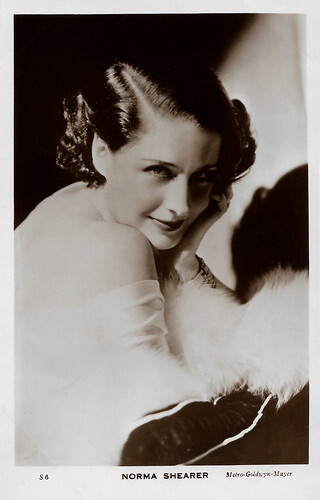
British postcard by W & G Ltd., no. S 6. Photo: George Hurrell, 1932 / MGM.
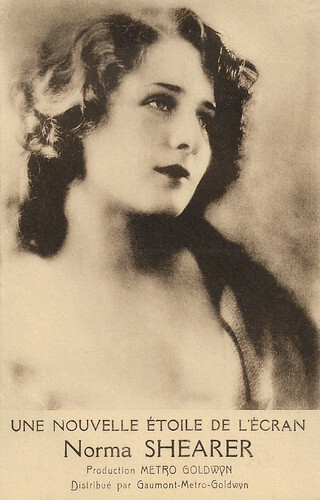
French postcard by Ets. La Deley, Paris for Gaumont-Metro-Goldwyn. Photo: Metro Goldwyn. Caption: a new screen star.
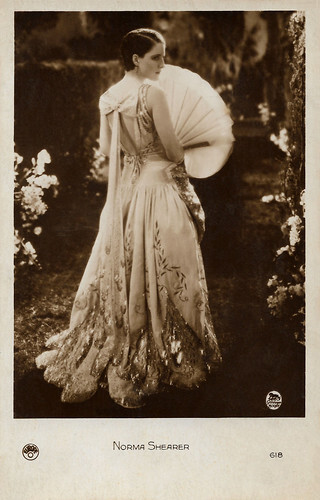
French postcard by Europe, no. 618. Photo: Metro-Goldwyn-Mayer.
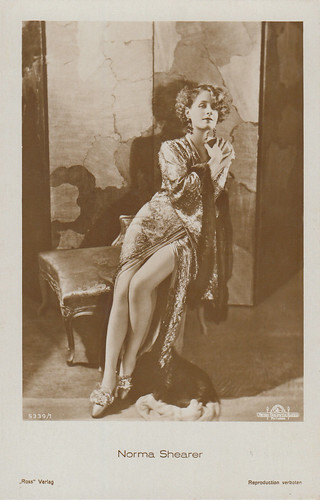
German postcard by Ross Verlag, no. 5339/1, 1930-1931. Photo: George Hurrell / Metro-Goldwyn-Mayer. Norma Shearer in Let Us Be Gay (Robert Z. Leonard, 1930). Collection: Marlene Pilaete.
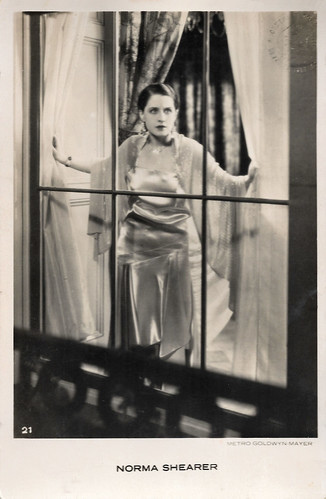
Dutch postcard, no. 21. Photo: Metro-Goldwyn-Mayer.
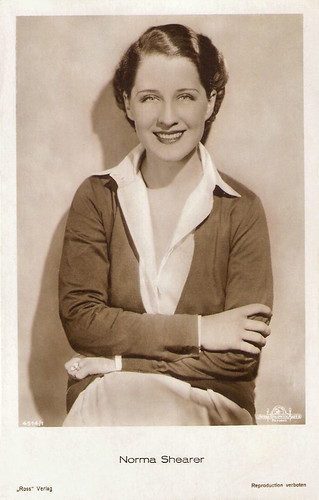
German postcard by Ross Verlag, no. 4514/1, 1929-1930. Photo: Metro-Goldwyn-Mayer.
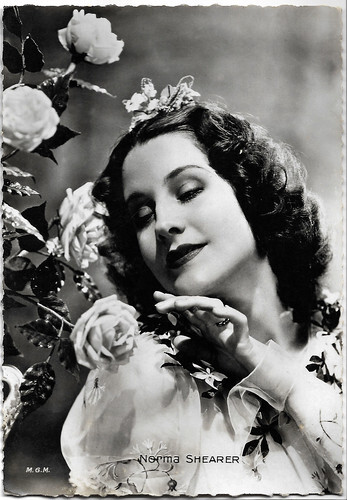
French postcard by Collection Chantal, Paris. Photo: M.G.M.
He Who Gets Slapped
Norma Shearer was born in 1902 in Montréal in Canada. In 1931, she would become a naturalised United States citizen. Her childhood was spent in Montreal, where her father had a construction business. Norma was educated at Montreal High School for Girls and Westmount High School.
At age fourteen, she won a beauty contest. In 1918, her father's company collapsed, and her older sister, Athole Shearer (later Mrs. Howard Hawks) suffered her first serious mental breakdown. Forced to move into a small, dreary house in a 'modest' Montreal suburb, the sudden plunge into poverty only strengthened Shearer's determined attitude.
In 1920 her mother, Edith Shearer, took Norma and her sister to New York. Florenz Ziegfeld rejected her for his Follies, but she got work as an extra at Universal. Other extra parts followed, including one in Way Down East (D. W. Griffith, 1920). She spent much money on eye doctor's services trying to correct her cross-eyed stare caused by muscle weakness.
A year after her arrival in New York, she received a break in the film business: fourth billing in the B-movie The Stealers (Christy Cabanne, 1921). Irving Thalberg had seen her early acting efforts and, when he joined Louis B. Mayer in 1923, gave her a five-year contract. Shearer was cast with Lon Chaney and John Gilbert in the MGM's first official production, He Who Gets Slapped (Victor Sjöström, 1924).
The film was a conspicuous success and contributed to the meteoric rise of the new company, and to Shearer's visibility. By late 1925, Norma Shearer was carrying her own films and was one of MGM's biggest attractions, a bona fide star. She signed a new contract; it paid $1,000 a week and would rise to $5,000 over the next five years. By 1927, Shearer had made a total of 13 silent films for MGM. Each had been produced for under $200,000, and had, without fail, been a substantial box-office hit, often making a $200,000+ profit for the studio.
She was rewarded for this consistent success by being cast in Ernst Lubitsch 's The Student Prince in Old Heidelberg (1927), her first prestige production, with a budget over $1,000,000. Privately, Thalberg was very impressed by Shearer. On 29 September 1927, they were married in the Hollywood wedding of the year. Thalberg thought she should retire after their marriage, but she wanted bigger parts. One week after the marriage, The Jazz Singer (Alan Crosland, 1927) was released. Norma's brother, Douglas Shearer, was instrumental in the development of sound at MGM, and every care was taken to prepare her for the microphone.
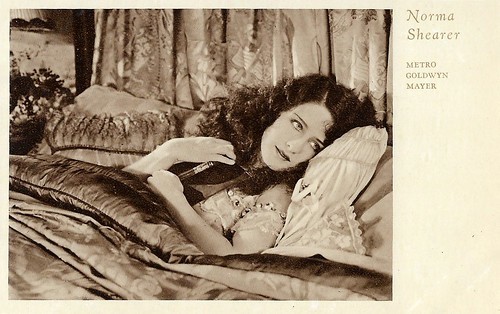
Italian postcard by Cinema-Illustrazione, series 1, no. 20. Photo: Metro-Goldwyn-Mayer. Norma Shearer in Broadway after Dark (Monta Bell, 1924).
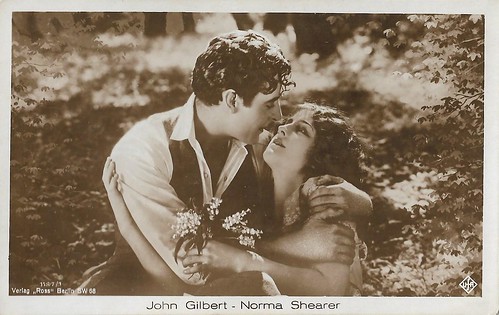
German postcard by Ross Verlag, Berlin, no. 1587/1. Photo: Ufa. John Gilbert and Norma Shearer in He Who Gets Slapped (Victor Sjöström, 1924).
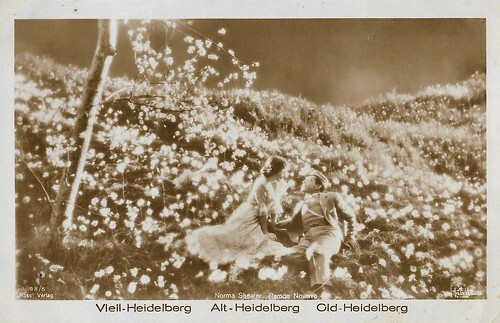
German postcard by Ross Verlag, Berlin, no. 98/5. Photo: Metro-Goldwyn-Mayer. Ramon Novarro and Norma Shearer in The Student Prince/ The Student Prince in Old Heidelberg (Ernst Lubitsch, 1927).
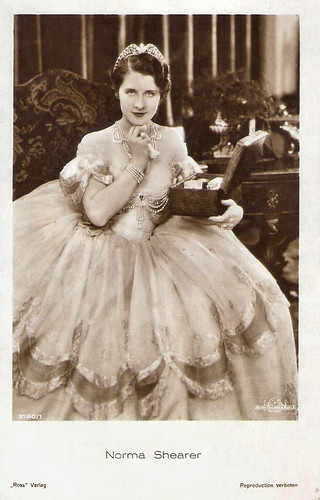
German postcard by Ross Verlag, no. 3880/1, 1928-1929. Photo: Metro-Goldwyn-Mayer. Norma Shearer in The Actress (Sidney Franklin, 1928).
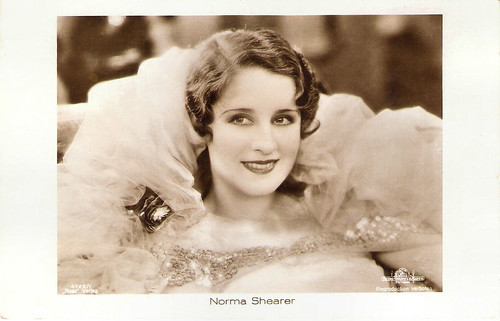
German postcard by Ross Verlag, no. 4129/1, 1929-1930. Photo: Metro-Goldwyn-Mayer.
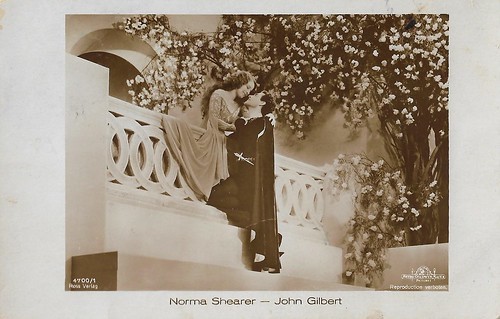
German postcard by Ross Verlag, no. 4700/1. Photo: Metro-Goldwyn-Mayer. Norma Shearer as Juliet and John Gilbert as Romeo in the early sound film The Hollywood Revue of 1929 (Charles Reisner, 1929), shot as a series of variety acts. In the film, this sequence was shot in two-color Technicolor.
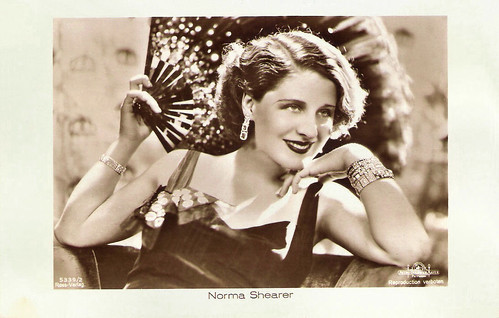
German postcard by Ross Verlag, no. 5339/2, 1930-1931. Photo: Metro-Goldwyn-Mayer. Norma Shearer in Let Us Be Gay (Robert Z. Leonard, 1930).
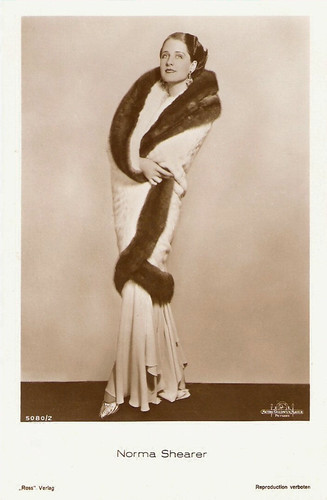
German postcard by Ross Verlag, no. 5080/2, 1930-1931. Photo: Metro-Goldwyn-Mayer. Norma Shearer in The Divorcee (Robert Z. Leonard, 1930).
The Women
Norma Shearer's first talkie was The Trial of Mary Dugan (Bayard Veiller, 1929) with Lewis Stone . Four films later, she won an Oscar in The Divorcee (Robert Z. Leonard, 1930). She intentionally cut down film exposure during the 1930s, relying on major roles in Thalberg's prestige projects: The Barretts of Wimpole Street (1934) and Romeo and Juliet (1936) (her fifth Oscar nomination).
Thalberg died of a second heart attack in September 1936, at age 37. Norma wanted to retire, but MGM more-or-less forced her into a six-picture contract. David O. Selznick offered her the part of Scarlett O'Hara in Gone with the Wind (1939), but the public objection to her cross-eyed stare killed the deal.
She starred in The Women (1939), turned down the starring role in Mrs. Miniver (1942), and retired in 1942. Later that year she married Sun Valley ski instructor Martin Arrouge, eleven years younger than she (he waived community property rights).
From then on, she shunned the limelight. Norma Shearer passed away in 1983 in Woodland Hills, California. She was 80 and had been in very poor health in the last decade of her life. Shearer is interred at Forest Lawn, Glendale, California, USA, in the Great Mausoleum, Sanctuary of Benediction, alongside her first husband Irving Thalberg.
Shearer had two children with Thalberg. Her son Irving Thalberg Jr (1930) died in 1988 of cancer. He was a philosophy professor at the University of Illinois at Chicago. Her daughter Katherine Thalberg (1935) died in 2006 of cancer. A vegan, she headed the Society for Animal Rights in Aspen, Colorado, from 1989.
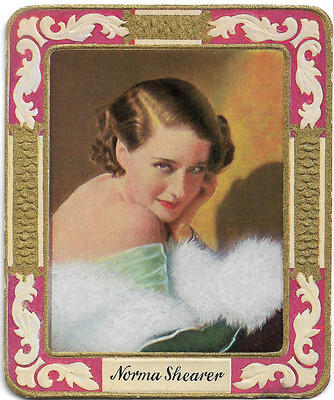
German cigarette card by Ross Verlag in the 'Moderne Schönheitsgalerie' series for Kurmark, no. 289. Photo: Metro-Goldwyn-Mayer (MGM).
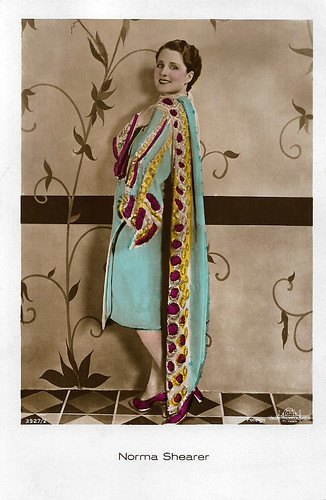
German postcard by Ross Verlag, Foreign, no. 3927/2, 1928-1929. Photo: Metro-Goldwyn-Mayer.
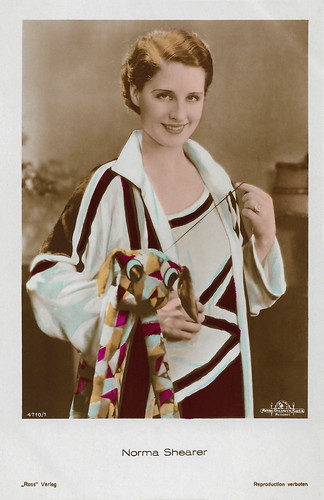
German postcard by Ross Verlag, no. 4710/1, 1929-1930. Photo: Metro-Goldwyn-Mayer. Collection: Geoffrey Donaldson Institute.
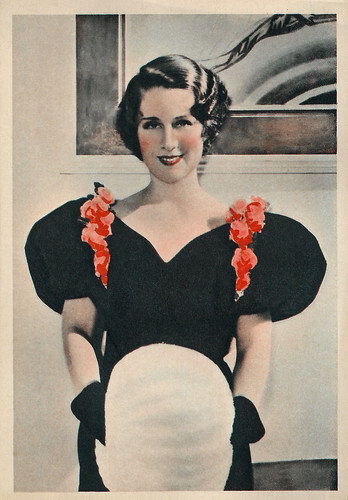
British postcard by De Reszke Cigarettes, no. 10. Photo: M.G.M. Caption: Norma Shearer started acting in school plays at 14, and went to New York in 1920. After several small parts, obtained feminine leads which brought her a Hollywood contract with M.G.M. In Hollywood she met her husband, Irving G. Thalberg, now head of production of M.G.M. Her performance in Divorcee won her the award of the year's best performance by an actress.
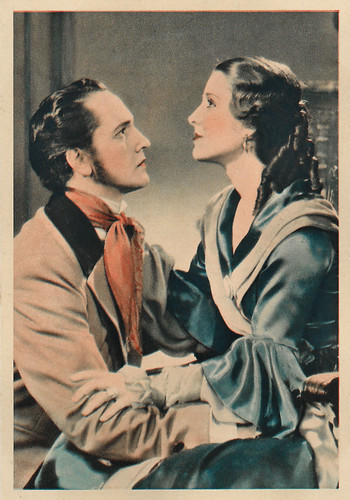
British postcard by Abdulla Cigarettes, no. 27. Photo: M.G.M. Fredric March and Norma Shearer in The Barretts of Wimpole Street (Sidney Franklin, 1934).

British postcard by Real Photograph, no. 103. Photo: Metro-Goldwyn-Mayer Pictures. Leslie Howard and Norma Shearer in Romeo and Juliet (George Cukor, 1936).
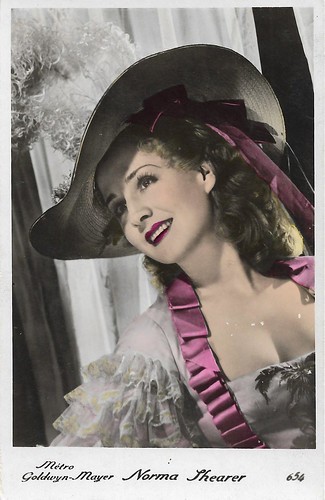
French postcard by Ed. Erpé, no. 654. Photo: Metro-Goldwyn-Mayer. Norma Shearer in Marie-Antoinette (W.S. Van Dyke, Julien Duvivier, 1938).
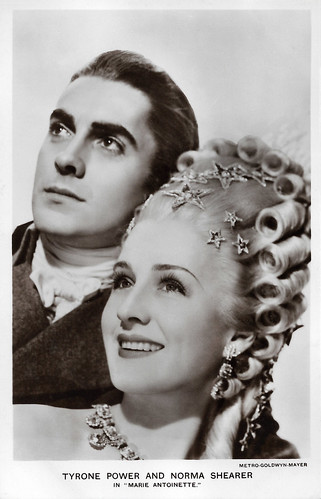
British Real Photograph postcard in the Film Partners series, London, no. P 254. Photo: Metro-Goldwyn-Mayer. Tyrone Power and Norma Shearer in Marie Antoinette (W.S. Van Dyke, 1938).
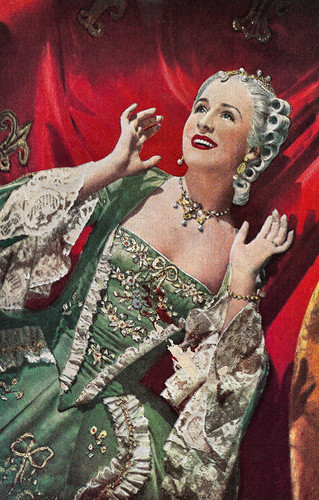
Yugoslavian (Croatian) postcard by St. Kugli, Zagreb. Photo: Metro-Goldwyn-Mayer. Norma Shearer in Marie Antoinette (W.S. Van Dyke, 1938).
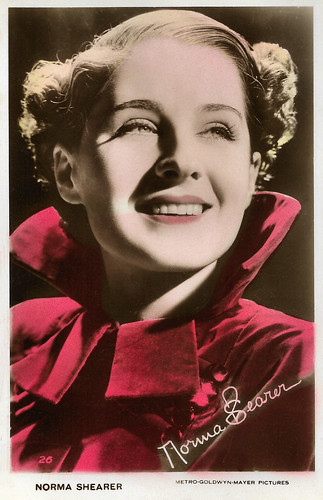
British postcard by Art Photo, no. 26. Photo: Metro-Goldwyn-Mayer.
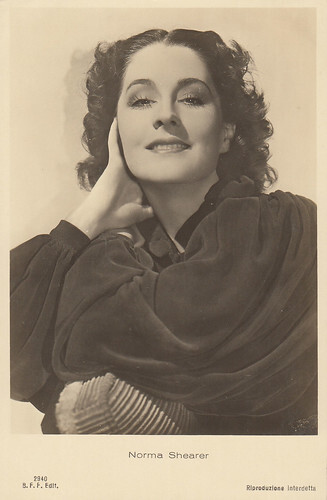
Italian postcard by B.F.F. Edit. no 2940. Collection: Marlene Pilaete. Marlene: I saw recently on TV a documentary about Anne Frank. They showed briefly the wall where Anne displayed movie star photos In fact, the photo used on this Ballerini e Fratini postcard is the same that Anne Frank choose to adorn her wall.
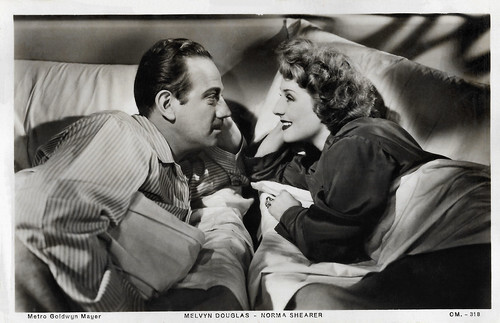
Spanish postcard, no. CM. -318. Photo: Metro-Goldwyn-Mayer. Melvyn Douglas and Norma Shearer in We Were Dancing (Robert Z. Leonard, 1942).
Sources: (IMDb), Wikipedia, and .

British postcard by W & G Ltd., no. S 6. Photo: George Hurrell, 1932 / MGM.

French postcard by Ets. La Deley, Paris for Gaumont-Metro-Goldwyn. Photo: Metro Goldwyn. Caption: a new screen star.

French postcard by Europe, no. 618. Photo: Metro-Goldwyn-Mayer.

German postcard by Ross Verlag, no. 5339/1, 1930-1931. Photo: George Hurrell / Metro-Goldwyn-Mayer. Norma Shearer in Let Us Be Gay (Robert Z. Leonard, 1930). Collection: Marlene Pilaete.

Dutch postcard, no. 21. Photo: Metro-Goldwyn-Mayer.

German postcard by Ross Verlag, no. 4514/1, 1929-1930. Photo: Metro-Goldwyn-Mayer.

French postcard by Collection Chantal, Paris. Photo: M.G.M.
He Who Gets Slapped
Norma Shearer was born in 1902 in Montréal in Canada. In 1931, she would become a naturalised United States citizen. Her childhood was spent in Montreal, where her father had a construction business. Norma was educated at Montreal High School for Girls and Westmount High School.
At age fourteen, she won a beauty contest. In 1918, her father's company collapsed, and her older sister, Athole Shearer (later Mrs. Howard Hawks) suffered her first serious mental breakdown. Forced to move into a small, dreary house in a 'modest' Montreal suburb, the sudden plunge into poverty only strengthened Shearer's determined attitude.
In 1920 her mother, Edith Shearer, took Norma and her sister to New York. Florenz Ziegfeld rejected her for his Follies, but she got work as an extra at Universal. Other extra parts followed, including one in Way Down East (D. W. Griffith, 1920). She spent much money on eye doctor's services trying to correct her cross-eyed stare caused by muscle weakness.
A year after her arrival in New York, she received a break in the film business: fourth billing in the B-movie The Stealers (Christy Cabanne, 1921). Irving Thalberg had seen her early acting efforts and, when he joined Louis B. Mayer in 1923, gave her a five-year contract. Shearer was cast with Lon Chaney and John Gilbert in the MGM's first official production, He Who Gets Slapped (Victor Sjöström, 1924).
The film was a conspicuous success and contributed to the meteoric rise of the new company, and to Shearer's visibility. By late 1925, Norma Shearer was carrying her own films and was one of MGM's biggest attractions, a bona fide star. She signed a new contract; it paid $1,000 a week and would rise to $5,000 over the next five years. By 1927, Shearer had made a total of 13 silent films for MGM. Each had been produced for under $200,000, and had, without fail, been a substantial box-office hit, often making a $200,000+ profit for the studio.
She was rewarded for this consistent success by being cast in Ernst Lubitsch 's The Student Prince in Old Heidelberg (1927), her first prestige production, with a budget over $1,000,000. Privately, Thalberg was very impressed by Shearer. On 29 September 1927, they were married in the Hollywood wedding of the year. Thalberg thought she should retire after their marriage, but she wanted bigger parts. One week after the marriage, The Jazz Singer (Alan Crosland, 1927) was released. Norma's brother, Douglas Shearer, was instrumental in the development of sound at MGM, and every care was taken to prepare her for the microphone.

Italian postcard by Cinema-Illustrazione, series 1, no. 20. Photo: Metro-Goldwyn-Mayer. Norma Shearer in Broadway after Dark (Monta Bell, 1924).

German postcard by Ross Verlag, Berlin, no. 1587/1. Photo: Ufa. John Gilbert and Norma Shearer in He Who Gets Slapped (Victor Sjöström, 1924).

German postcard by Ross Verlag, Berlin, no. 98/5. Photo: Metro-Goldwyn-Mayer. Ramon Novarro and Norma Shearer in The Student Prince/ The Student Prince in Old Heidelberg (Ernst Lubitsch, 1927).

German postcard by Ross Verlag, no. 3880/1, 1928-1929. Photo: Metro-Goldwyn-Mayer. Norma Shearer in The Actress (Sidney Franklin, 1928).

German postcard by Ross Verlag, no. 4129/1, 1929-1930. Photo: Metro-Goldwyn-Mayer.

German postcard by Ross Verlag, no. 4700/1. Photo: Metro-Goldwyn-Mayer. Norma Shearer as Juliet and John Gilbert as Romeo in the early sound film The Hollywood Revue of 1929 (Charles Reisner, 1929), shot as a series of variety acts. In the film, this sequence was shot in two-color Technicolor.

German postcard by Ross Verlag, no. 5339/2, 1930-1931. Photo: Metro-Goldwyn-Mayer. Norma Shearer in Let Us Be Gay (Robert Z. Leonard, 1930).

German postcard by Ross Verlag, no. 5080/2, 1930-1931. Photo: Metro-Goldwyn-Mayer. Norma Shearer in The Divorcee (Robert Z. Leonard, 1930).
The Women
Norma Shearer's first talkie was The Trial of Mary Dugan (Bayard Veiller, 1929) with Lewis Stone . Four films later, she won an Oscar in The Divorcee (Robert Z. Leonard, 1930). She intentionally cut down film exposure during the 1930s, relying on major roles in Thalberg's prestige projects: The Barretts of Wimpole Street (1934) and Romeo and Juliet (1936) (her fifth Oscar nomination).
Thalberg died of a second heart attack in September 1936, at age 37. Norma wanted to retire, but MGM more-or-less forced her into a six-picture contract. David O. Selznick offered her the part of Scarlett O'Hara in Gone with the Wind (1939), but the public objection to her cross-eyed stare killed the deal.
She starred in The Women (1939), turned down the starring role in Mrs. Miniver (1942), and retired in 1942. Later that year she married Sun Valley ski instructor Martin Arrouge, eleven years younger than she (he waived community property rights).
From then on, she shunned the limelight. Norma Shearer passed away in 1983 in Woodland Hills, California. She was 80 and had been in very poor health in the last decade of her life. Shearer is interred at Forest Lawn, Glendale, California, USA, in the Great Mausoleum, Sanctuary of Benediction, alongside her first husband Irving Thalberg.
Shearer had two children with Thalberg. Her son Irving Thalberg Jr (1930) died in 1988 of cancer. He was a philosophy professor at the University of Illinois at Chicago. Her daughter Katherine Thalberg (1935) died in 2006 of cancer. A vegan, she headed the Society for Animal Rights in Aspen, Colorado, from 1989.

German cigarette card by Ross Verlag in the 'Moderne Schönheitsgalerie' series for Kurmark, no. 289. Photo: Metro-Goldwyn-Mayer (MGM).

German postcard by Ross Verlag, Foreign, no. 3927/2, 1928-1929. Photo: Metro-Goldwyn-Mayer.

German postcard by Ross Verlag, no. 4710/1, 1929-1930. Photo: Metro-Goldwyn-Mayer. Collection: Geoffrey Donaldson Institute.

British postcard by De Reszke Cigarettes, no. 10. Photo: M.G.M. Caption: Norma Shearer started acting in school plays at 14, and went to New York in 1920. After several small parts, obtained feminine leads which brought her a Hollywood contract with M.G.M. In Hollywood she met her husband, Irving G. Thalberg, now head of production of M.G.M. Her performance in Divorcee won her the award of the year's best performance by an actress.

British postcard by Abdulla Cigarettes, no. 27. Photo: M.G.M. Fredric March and Norma Shearer in The Barretts of Wimpole Street (Sidney Franklin, 1934).

British postcard by Real Photograph, no. 103. Photo: Metro-Goldwyn-Mayer Pictures. Leslie Howard and Norma Shearer in Romeo and Juliet (George Cukor, 1936).

French postcard by Ed. Erpé, no. 654. Photo: Metro-Goldwyn-Mayer. Norma Shearer in Marie-Antoinette (W.S. Van Dyke, Julien Duvivier, 1938).

British Real Photograph postcard in the Film Partners series, London, no. P 254. Photo: Metro-Goldwyn-Mayer. Tyrone Power and Norma Shearer in Marie Antoinette (W.S. Van Dyke, 1938).

Yugoslavian (Croatian) postcard by St. Kugli, Zagreb. Photo: Metro-Goldwyn-Mayer. Norma Shearer in Marie Antoinette (W.S. Van Dyke, 1938).

British postcard by Art Photo, no. 26. Photo: Metro-Goldwyn-Mayer.

Italian postcard by B.F.F. Edit. no 2940. Collection: Marlene Pilaete. Marlene: I saw recently on TV a documentary about Anne Frank. They showed briefly the wall where Anne displayed movie star photos In fact, the photo used on this Ballerini e Fratini postcard is the same that Anne Frank choose to adorn her wall.

Spanish postcard, no. CM. -318. Photo: Metro-Goldwyn-Mayer. Melvyn Douglas and Norma Shearer in We Were Dancing (Robert Z. Leonard, 1942).
Sources: (IMDb), Wikipedia, and .
Published on April 28, 2022 22:00
April 27, 2022
Janette Scott
Janette Scott (1938) is a retired English actress, who started her career as a child actress at the age of 3. From the late 1950s to the mid-1960s, she was a leading lady in British films in which she co-starred with Terry-Thomas, Ian Carmichael, and Laurence Olivier. She is best remembered from the line "And I really got hot When I saw Janette Scott fight a triffid that spits poison and kills" in the opening song of The Rocky Horror Picture Show (1975). Scott gave up her film career upon marrying singer Mel Torme.
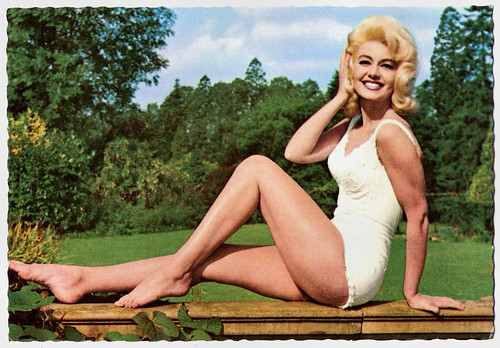
German postcard by ISV, Sort 14/6. Photo: Janette Scott in The Beauty Jungle (Val Guest, 1964).
Her first screen kiss
Thora Janette Scott was born in 1938 in Morecambe, Lancashire, England. She is the daughter of actors Jimmy Scott and Thora Hird and began her acting career as a child actress known as Janette Scott.
She made her film debut only 3-years-old in the British war film Went the Day Well? (Alberto Cavalcanti, 1942), adapted from a story by Graham Greene. The film was produced by Michael Balcon of Ealing Studios and served as unofficial propaganda for the war effort. It tells of how an English village is taken over by German paratroopers.
After a few bit roles, she had her first big part as Jennifer in No Place for Jennifer (Henry Cass, 1950) with Leo Genn and Rosamund John . She played a young girl, who experiences a trauma when her parents' divorce. Another big role followed in the sports comedy The Galloping Major (Henry Cornelius, 1951), starring Basil Radford. The title is taken from the song 'The Galloping Major', and the plot was centered on gambling at the horse racing track.
She also co-starred in the British 20th Century Fox production No Highway in the Sky/No Highway (Henry Koster, 1951), starring James Stewart and Marlene Dietrich . Scott appeared in the British Technicolor biographical drama The Magic Box (John Boulting, 1951). The film stars Robert Donat as William Friese-Greene, who first designed and patented one of the earliest working cinematic cameras. Told in flashback, the film details Friese-Greene's tireless experiments with the 'moving image', leading inexorably to a series of failures and disappointments, as others hog the credit for the protagonist's discoveries.
Scott was briefly (along with Jennifer Gay) one of the so-called 'Children's Announcers' providing continuity links for the BBC's children's TV programs in the early 1950s. At the age of 14, Scott wrote her autobiography, 'Act One'. During the 1950s, she also appeared in such films as the divorce drama Background/Edge of Divorce (Daniel Birt, 1953) starring Valerie Hobson , the musical comedy As Long as They're Happy (J. Lee Thompson, 1955) starring Jack Buchanan and Diana Dors , and as Cassandra in the Hollywood epic Helen of Troy (Robert Wise, 1956), based on Homer's 'Iliad' and 'Odyssey'. Scott also had the leading role in the romance Now and Forever (Mario Zampi, 1956). It was Scott's first adult role in which she got her first screen kiss.
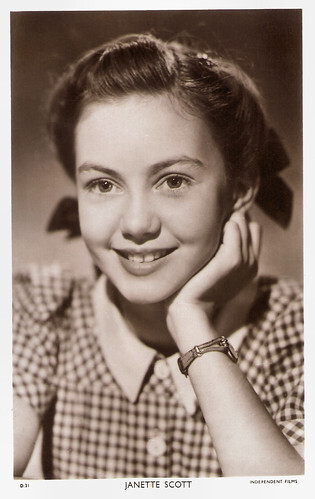
British postcard in the Picturegoer Series, London, no. D 31. Photo: Independent Films.
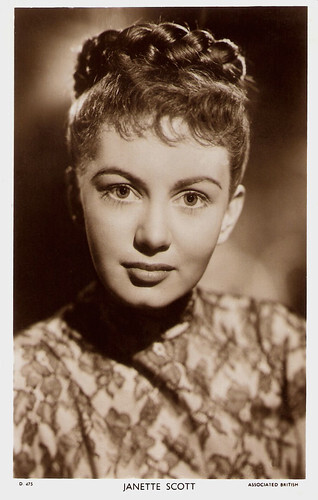
British postcard in the Picturegoer Series, London, no. D 475. Photo: Associated British.
Fighting a triffid that spits poison and kills
In the late 1950s, Janette Scott became a popular leading lady. She appeared with Ian Carmichael in the comedy Happy Is the Bride (Roy Boulting, 1958), and with Anna Neagle and Frankie Vaughan in The Lady is a Square (Herbert Wilcox, 1958). She is known to American audiences for her role as the parson's wife in The Devil's Disciple (Guy Hamilton, 1959) starring Burt Lancaster , Kirk Douglas , and Laurence Olivier .
One of her other well-known roles is April Smith in the British comedy School for Scoundrels (Robert Hamer, 1960), based on the 'one-upmanship' books by Stephen Potter, in which Ian Carmichael and Terry-Thomas competed for her attention. Scott is referenced to in the song 'Science Fiction/Double Feature', the opening number from 'The Rocky Horror Show' and its film version The Rocky Horror Picture Show (Jim Sharman, 1975) for her participation in The Day of the Triffids (Steve Sekely, 1962): "And I really got hot When I saw Janette Scott fight a triffid that spits poison and kills." The British Science Fiction film stars Howard Keel and Nicole Maurey and was loosely based on the 1951 novel of the same name by John Wyndham.
She later appeared in the Hammer thriller Paranoiac (Freddie Francis, 1963) with Oliver Reed , Siege of the Saxons (Nathan H. Juran, 1963), set in the time of King Arthur, and the American horror-comedy The Old Dark House (William Castle, 1963), a remake of the 1932 film by James Whale. The photo of the postcard at the top of the post was produced for The Beauty Jungle/Contest Girl (Val Guest, 1964), about "the beauty profession and all of its hypocrisy and sordid publicity stunts", according to Wikipedia . Ordinarily a brunette, Scott dyed her hair blonde to take on a sort of sex bomb persona for the film.
Her final films were the American Science-Fiction Crack in the World (Andrew Marton, 1965) a 'doomsday disaster movie' filmed in Spain, and the American comedy Bikini Paradise/White Savage (Gregg Tallas, 1967). In the meantime, she had married American Jazz singer Mel Torme and gave up her career to raise a family. Janette Scott has been married three times: to Canadian singer and TV host Jackie Rae (1959-1965; divorced), Mel Tormé (1966-1977; divorced), and William Rademaekers (since 1981).
With Mel Tormé, she has two children, actress Daisy Tormé (1969) and songwriter James Tormé (1973). In 1997, she returned to the screen for a cameo in the popular TV series Last of the Summer Wine in the episode There Goes the Groom. Although she is credited in the cast of the British film How to Lose Friends & Alienate People (Robert B. Weide, 2008), Scott did not return to the cinema. Her character - the deceased mother of the Simon Pegg character - is seen only in flashbacks as a very young woman, extracts from her film Now and Forever (Mario Zampi, 1956).
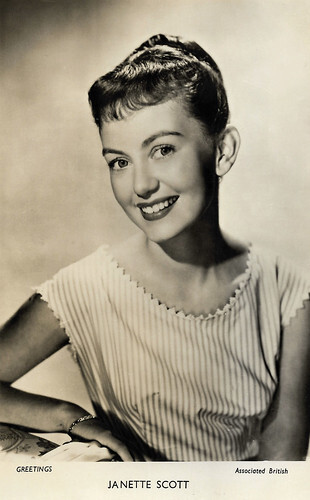
British postcard in the Greetings Series. Photo: Associated British.
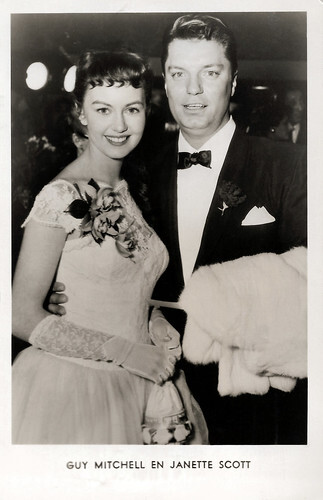
Vintage postcard, no 5023. Janette Scott and Guy Mitchell.
Sources: Brian Drive-in's Theater, Wikipedia, and .

German postcard by ISV, Sort 14/6. Photo: Janette Scott in The Beauty Jungle (Val Guest, 1964).
Her first screen kiss
Thora Janette Scott was born in 1938 in Morecambe, Lancashire, England. She is the daughter of actors Jimmy Scott and Thora Hird and began her acting career as a child actress known as Janette Scott.
She made her film debut only 3-years-old in the British war film Went the Day Well? (Alberto Cavalcanti, 1942), adapted from a story by Graham Greene. The film was produced by Michael Balcon of Ealing Studios and served as unofficial propaganda for the war effort. It tells of how an English village is taken over by German paratroopers.
After a few bit roles, she had her first big part as Jennifer in No Place for Jennifer (Henry Cass, 1950) with Leo Genn and Rosamund John . She played a young girl, who experiences a trauma when her parents' divorce. Another big role followed in the sports comedy The Galloping Major (Henry Cornelius, 1951), starring Basil Radford. The title is taken from the song 'The Galloping Major', and the plot was centered on gambling at the horse racing track.
She also co-starred in the British 20th Century Fox production No Highway in the Sky/No Highway (Henry Koster, 1951), starring James Stewart and Marlene Dietrich . Scott appeared in the British Technicolor biographical drama The Magic Box (John Boulting, 1951). The film stars Robert Donat as William Friese-Greene, who first designed and patented one of the earliest working cinematic cameras. Told in flashback, the film details Friese-Greene's tireless experiments with the 'moving image', leading inexorably to a series of failures and disappointments, as others hog the credit for the protagonist's discoveries.
Scott was briefly (along with Jennifer Gay) one of the so-called 'Children's Announcers' providing continuity links for the BBC's children's TV programs in the early 1950s. At the age of 14, Scott wrote her autobiography, 'Act One'. During the 1950s, she also appeared in such films as the divorce drama Background/Edge of Divorce (Daniel Birt, 1953) starring Valerie Hobson , the musical comedy As Long as They're Happy (J. Lee Thompson, 1955) starring Jack Buchanan and Diana Dors , and as Cassandra in the Hollywood epic Helen of Troy (Robert Wise, 1956), based on Homer's 'Iliad' and 'Odyssey'. Scott also had the leading role in the romance Now and Forever (Mario Zampi, 1956). It was Scott's first adult role in which she got her first screen kiss.

British postcard in the Picturegoer Series, London, no. D 31. Photo: Independent Films.

British postcard in the Picturegoer Series, London, no. D 475. Photo: Associated British.
Fighting a triffid that spits poison and kills
In the late 1950s, Janette Scott became a popular leading lady. She appeared with Ian Carmichael in the comedy Happy Is the Bride (Roy Boulting, 1958), and with Anna Neagle and Frankie Vaughan in The Lady is a Square (Herbert Wilcox, 1958). She is known to American audiences for her role as the parson's wife in The Devil's Disciple (Guy Hamilton, 1959) starring Burt Lancaster , Kirk Douglas , and Laurence Olivier .
One of her other well-known roles is April Smith in the British comedy School for Scoundrels (Robert Hamer, 1960), based on the 'one-upmanship' books by Stephen Potter, in which Ian Carmichael and Terry-Thomas competed for her attention. Scott is referenced to in the song 'Science Fiction/Double Feature', the opening number from 'The Rocky Horror Show' and its film version The Rocky Horror Picture Show (Jim Sharman, 1975) for her participation in The Day of the Triffids (Steve Sekely, 1962): "And I really got hot When I saw Janette Scott fight a triffid that spits poison and kills." The British Science Fiction film stars Howard Keel and Nicole Maurey and was loosely based on the 1951 novel of the same name by John Wyndham.
She later appeared in the Hammer thriller Paranoiac (Freddie Francis, 1963) with Oliver Reed , Siege of the Saxons (Nathan H. Juran, 1963), set in the time of King Arthur, and the American horror-comedy The Old Dark House (William Castle, 1963), a remake of the 1932 film by James Whale. The photo of the postcard at the top of the post was produced for The Beauty Jungle/Contest Girl (Val Guest, 1964), about "the beauty profession and all of its hypocrisy and sordid publicity stunts", according to Wikipedia . Ordinarily a brunette, Scott dyed her hair blonde to take on a sort of sex bomb persona for the film.
Her final films were the American Science-Fiction Crack in the World (Andrew Marton, 1965) a 'doomsday disaster movie' filmed in Spain, and the American comedy Bikini Paradise/White Savage (Gregg Tallas, 1967). In the meantime, she had married American Jazz singer Mel Torme and gave up her career to raise a family. Janette Scott has been married three times: to Canadian singer and TV host Jackie Rae (1959-1965; divorced), Mel Tormé (1966-1977; divorced), and William Rademaekers (since 1981).
With Mel Tormé, she has two children, actress Daisy Tormé (1969) and songwriter James Tormé (1973). In 1997, she returned to the screen for a cameo in the popular TV series Last of the Summer Wine in the episode There Goes the Groom. Although she is credited in the cast of the British film How to Lose Friends & Alienate People (Robert B. Weide, 2008), Scott did not return to the cinema. Her character - the deceased mother of the Simon Pegg character - is seen only in flashbacks as a very young woman, extracts from her film Now and Forever (Mario Zampi, 1956).

British postcard in the Greetings Series. Photo: Associated British.

Vintage postcard, no 5023. Janette Scott and Guy Mitchell.
Sources: Brian Drive-in's Theater, Wikipedia, and .
Published on April 27, 2022 22:00
April 26, 2022
Fernanda (1917)
Italian film diva Leda Gys (1892-1957) starred in ca. 60 dramas, comedies, action thrillers, and even Westerns of the Italian and Spanish silent cinema. In 1917, she starred in the silent Italian film Fernanda, directed by Gustavo Serena and based on a play by Victorien Sardou. Ivo Blom found two, incomplete series of Spanish collectors cards for the film. Both series were once supplements in chocolate boxes of two different manufacturers
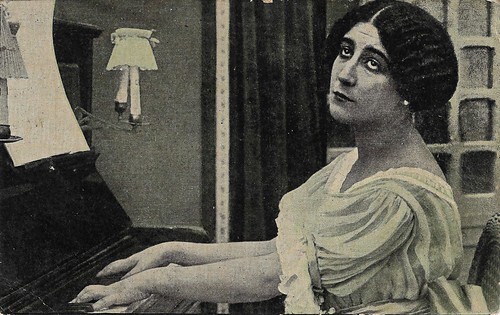
Spanish collectors card by Chocolate Imperiale, Barcelona, series of 6 cromos, no. 1. Leda Gys in Fernanda (Gustavo Serena, 1917).
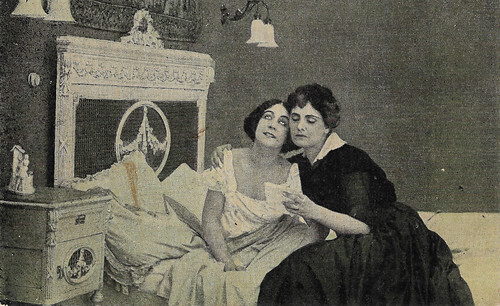
Spanish collectors card by Chocolate Imperiale, Barcelona, series of 6 cromos, no. 3. Leda Gys in Fernanda (Gustavo Serena, 1917). Here we see Fernanda and her mother (Olga Vannelli).
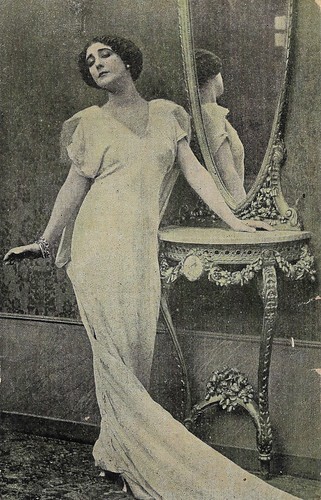
Spanish collectors card by Chocolate Imperiale, Barcelona, series of 6 cromos, no. 4. Leda Gys in Fernanda (Gustavo Serena, 1917).
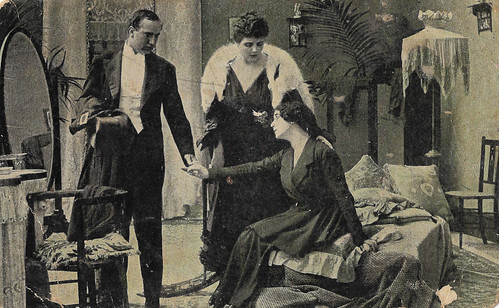
Spanish collectors card by Chocolate Imperiale, Barcelona, series of 6 cromos, no. 5. Leda Gys , Gustavo Serena and Olga Benetti in Fernanda (Gustavo Serena, 1917).
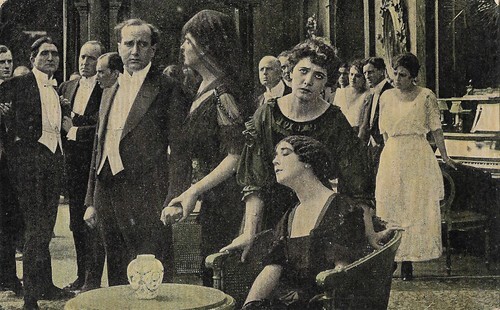
Spanish collectors card by Chocolate Imperiale, Barcelona, series of 6 cromos, no. 6. Leda Gys , Gustavo Serena and Olga Benetti in Fernanda (Gustavo Serena, 1917). The woman with the veil is Olga Benetti, left in the back Orlando Ricci as Roqueville.
Growing up in an illegal gambling house
Fernanda's father kills himself when he goes bankrupt. Her mother (Olga Vannelli) fights poverty and in order to save her daughter, she accepts to run an illegal gambling house. In this milieu young Fernanda ( Leda Gys ) grows up to be an attractive young girl. The bandit Roqueville (Orlando Ricci) lusts for her but when rejected by Fernanda, he denounces her mother who is arrested.
Left alone, Fernanda is promised by Roqueville that her mother will be freed once Fernanda accepts to marry him. She tries to commit suicide by throwing herself before a car, but she is saved by the ones in the car, the lawyer Giorgio Pomeral ( Gustavo Serena ) and his cousin, the widowed marchioness Clotilde ( Olga Benetti ). The terrible experience has matured Fernanda.
The marquis d'Arcis (Alfredo de Antoni), who is about to marry Clotilde, falls in love with Fernanda and wants to marry her. The dumped Clotilde takes revenge by intercepting a written confession of Fernanda to her future husband about her past. She thus reveals after the wedding the past of Fernanda. The husband throws his newlywed young wife out of the house, thinking she is a slut. In the end, the marquis knows to pardon his wife because when the letter resurfaces, he is assured that the purity and honesty of his wife have never been tainted.
Fernanda had its premiere in Rome on 16 February 1917. While the Turinese Rivista cinematografica thought Gys should better stick to comedy, instead Tito Alacevich, for the Neapolitan journal Film considered her performance and that of the others well done and to the point. He also praised the vivacity and the cinematography but missed the couleur locale of Paris and the Parisians; veracity, in short. Fernanda was internationally well distributed all over Europe.
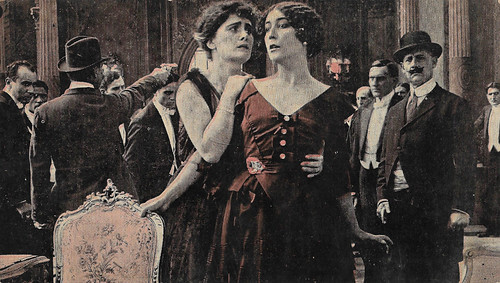
Spanish collectors card by Chocolate Salas-Sabadell, series of 6 cards, no. 3. Leda Gys in Fernanda (Gustavo Serena, 1917). This is probably the moment Fernanda's mother (Olga Vannelli) is arrested by the police.
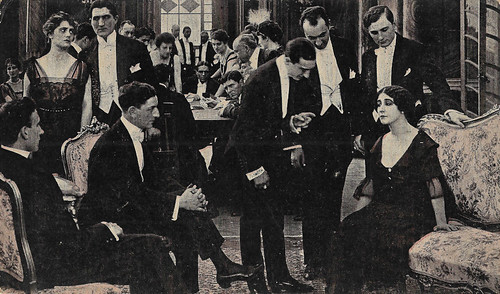
Spanish collectors card by Chocolate Salas-Sabadell, series of 6 cards, no. 4. Leda Gys in Fernanda (Gustavo Serena, 1917). The characters standing left must be Olga Vannelli (Fernanda's mother) and Orlando Ricco (Roqueville), one notices the gambling table in the back.
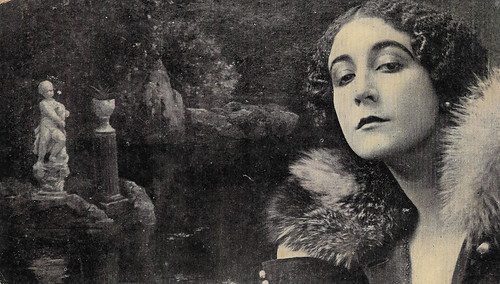
Spanish collectors card by Chocolate Salas-Sabadell, series of 6 cards, no. 6. Leda Gys in Fernanda (Gustavo Serena, 1917).
Source: Vittorio Martinelli (Il cinema muto italiano) and IMDb.

Spanish collectors card by Chocolate Imperiale, Barcelona, series of 6 cromos, no. 1. Leda Gys in Fernanda (Gustavo Serena, 1917).

Spanish collectors card by Chocolate Imperiale, Barcelona, series of 6 cromos, no. 3. Leda Gys in Fernanda (Gustavo Serena, 1917). Here we see Fernanda and her mother (Olga Vannelli).

Spanish collectors card by Chocolate Imperiale, Barcelona, series of 6 cromos, no. 4. Leda Gys in Fernanda (Gustavo Serena, 1917).

Spanish collectors card by Chocolate Imperiale, Barcelona, series of 6 cromos, no. 5. Leda Gys , Gustavo Serena and Olga Benetti in Fernanda (Gustavo Serena, 1917).

Spanish collectors card by Chocolate Imperiale, Barcelona, series of 6 cromos, no. 6. Leda Gys , Gustavo Serena and Olga Benetti in Fernanda (Gustavo Serena, 1917). The woman with the veil is Olga Benetti, left in the back Orlando Ricci as Roqueville.
Growing up in an illegal gambling house
Fernanda's father kills himself when he goes bankrupt. Her mother (Olga Vannelli) fights poverty and in order to save her daughter, she accepts to run an illegal gambling house. In this milieu young Fernanda ( Leda Gys ) grows up to be an attractive young girl. The bandit Roqueville (Orlando Ricci) lusts for her but when rejected by Fernanda, he denounces her mother who is arrested.
Left alone, Fernanda is promised by Roqueville that her mother will be freed once Fernanda accepts to marry him. She tries to commit suicide by throwing herself before a car, but she is saved by the ones in the car, the lawyer Giorgio Pomeral ( Gustavo Serena ) and his cousin, the widowed marchioness Clotilde ( Olga Benetti ). The terrible experience has matured Fernanda.
The marquis d'Arcis (Alfredo de Antoni), who is about to marry Clotilde, falls in love with Fernanda and wants to marry her. The dumped Clotilde takes revenge by intercepting a written confession of Fernanda to her future husband about her past. She thus reveals after the wedding the past of Fernanda. The husband throws his newlywed young wife out of the house, thinking she is a slut. In the end, the marquis knows to pardon his wife because when the letter resurfaces, he is assured that the purity and honesty of his wife have never been tainted.
Fernanda had its premiere in Rome on 16 February 1917. While the Turinese Rivista cinematografica thought Gys should better stick to comedy, instead Tito Alacevich, for the Neapolitan journal Film considered her performance and that of the others well done and to the point. He also praised the vivacity and the cinematography but missed the couleur locale of Paris and the Parisians; veracity, in short. Fernanda was internationally well distributed all over Europe.

Spanish collectors card by Chocolate Salas-Sabadell, series of 6 cards, no. 3. Leda Gys in Fernanda (Gustavo Serena, 1917). This is probably the moment Fernanda's mother (Olga Vannelli) is arrested by the police.

Spanish collectors card by Chocolate Salas-Sabadell, series of 6 cards, no. 4. Leda Gys in Fernanda (Gustavo Serena, 1917). The characters standing left must be Olga Vannelli (Fernanda's mother) and Orlando Ricco (Roqueville), one notices the gambling table in the back.

Spanish collectors card by Chocolate Salas-Sabadell, series of 6 cards, no. 6. Leda Gys in Fernanda (Gustavo Serena, 1917).
Source: Vittorio Martinelli (Il cinema muto italiano) and IMDb.
Published on April 26, 2022 22:00
April 25, 2022
Dorrit Weixler
German silent film actress Dorrit Weixler (1892-1916) anticipated such better-known comedy stars of the German cinema as Ossi Oswalda and Anny Ondra. The career of the bright and light comedienne was like a candle burning on both sides.
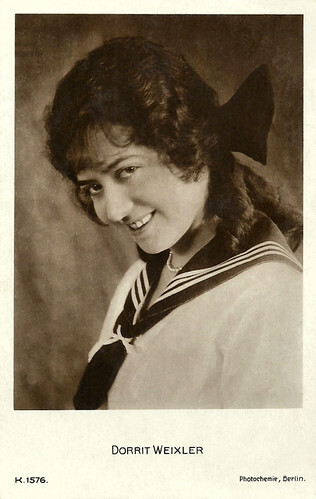
German postcard by Photochemie, Berlin, no. K. 1576.
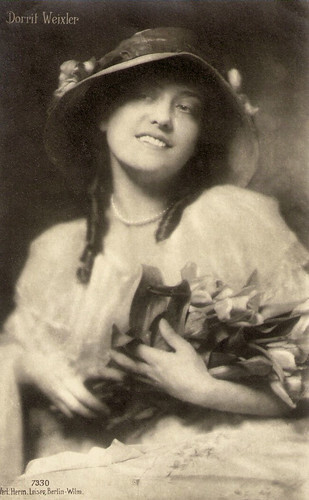
German Postcard by Verlag Hermann Leiser, Berlin-Wilm, no. 7330.
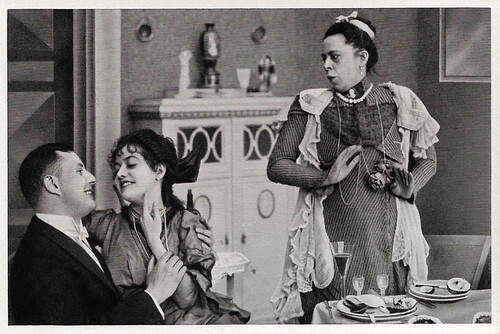
German collectors card by Ross Verlag in the series Vom Werden Deutscher Filmkunst - Der Stumme Film, no. 45, group 43. Photo: Tobias-Film. Bruno Kastner , Dorrit Weixler and Frida Richard in Dorittchens Vergnügungsreise/Little Dorrit's Pleasure Trip (Paul Heidemann, 1916).
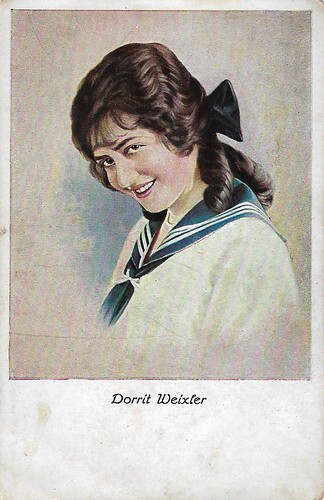
German postcard in the Moderne Künstler series by MMB, no. 455. Photo: F.J. Wesselsky.
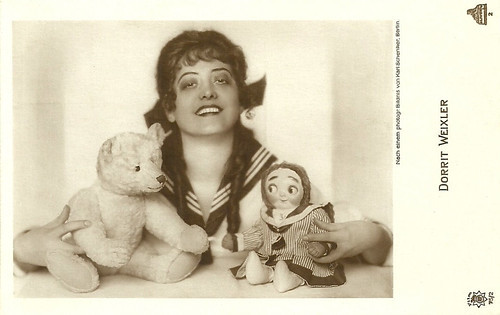
German postcard in the Film-Sterne series by Rotophot, no. 75/2. Photo: Karl Schenker, Berlin / Oliver-Film.
Quicksilver
Dorrit Weixler was born in 1892. The actress Grete Weixler was her younger sister.
She first appeared in short films in 1911, like Seine erste Liebe/His First Love (Alwin Neuss, 1911) and Alwin auf der Hochzeitsreise/Alwin's Honeymoon Trip (Alwin Neuss, 1911), both featuring Alwin Neuss .
In 1913 she began a successful collaboration with silent film director-screenwriter Franz Hofer at the Luna Film studio. She had her breakthrough with Das rosa Pantöffelchen/The Pink Slipper (Franz Hofer, 1913) with Franz Schwaiger.
Hofer and Weixler would make ten films together such as Das Liebesbarometer/The Barometer of Love (Franz Hofer, 1914). In Ein verliebter Racker/A Rascal in Love (Franz Hofer, 1915) and Fraülein Piccolo/Miss piccolo (Franz Hofer, 1915) her film partner was the future film director Ernst Lubitsch . In Fraülein Piccolo she played a quicksilver waitress dressed up as a boy to push away the clients.
Other popular roles were the temperamental teenager or the tomboy in a sailor suit who is tamed by the 'right man'. During the First World War, Hofer directed her also in such patriotic war dramas as Deutsche Helden/German heroes (Franz Hofer, 1914) and Weihnachtsglöckchen/Christmas Bells (Franz Hofer, 1914).
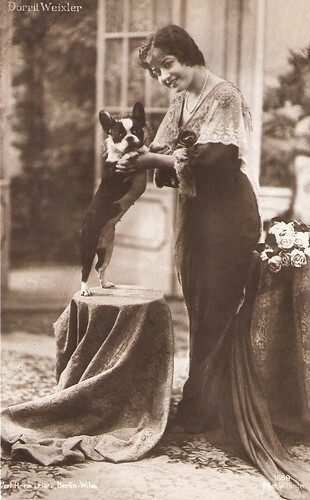
German postcard by Verlag Hermann Leiser, Berlin-Wilm., no. 1550. Photo: Willinger.
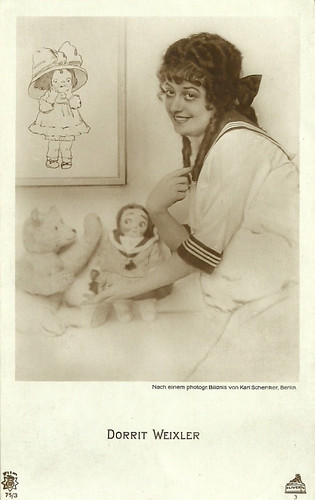
German postcard in the Film-Sterne series by Rotophot, no. 75/3. Photo: Karl Schenker, Berlin / Oliver-Film, 3.
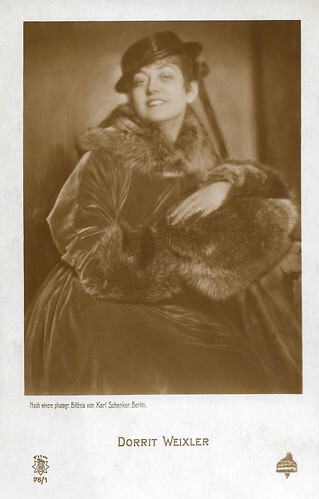
German postcard in the Film-Sterne series by Rotophot, no. 76/1. Photo: Karl Schenker, Berlin / Oliver-Film.
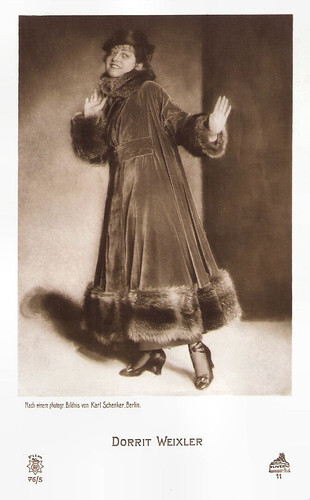
German postcard in the Film Sterne series by Rotophot, no. 76/5. Photo: Karl Schenker, Berlin.
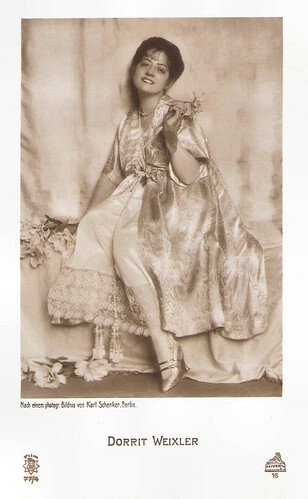
German postcard in the Film Sterne series by Rotophot, no. 77/4. Photo: Karl Schenker, Berlin.
Stress
In 1915, Dorrit Weixler left Hofer and Luna Film to work for producer David Oliver at Oliver-Film, where she became the leading actress. Her type of roles stayed the same, and her directors Paul Otto and Paul Heidemann were often also her partners on screen.
The films were all about her and sometimes bore her name in the titles. Examples are Dorrits Chauffeur (Paul Otto, 1915) and Dorritts Vergnügungsreise/Dorritts pleasure trip (Paul Heidemann, 1916) opposite Bruno Kastner .
End of May 1916, she made her stage debut in the Theater am Nollendorfplatz in a 'Dorrit Weixler-week'. One night she collapsed on stage. Unfortunately the stress of turning out one film after another - over 20 films in two years - had been too much for Dorrit.
While trying to recover in a Berlin sanatorium, matters grew worse. She became dependent on morphine. In 1916, at the apex of her success, Dorrit Weixler committed suicide by hanging herself. She was only 24 years old.
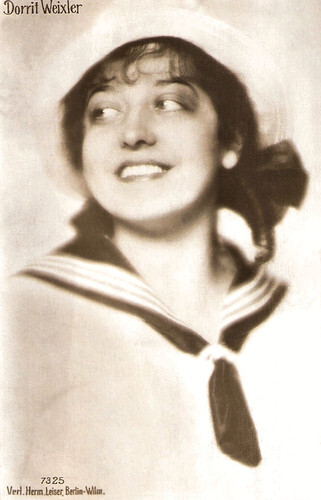
German postcard by Verlag Hermann Leiser, Berlin-Wilm., no. 7325.
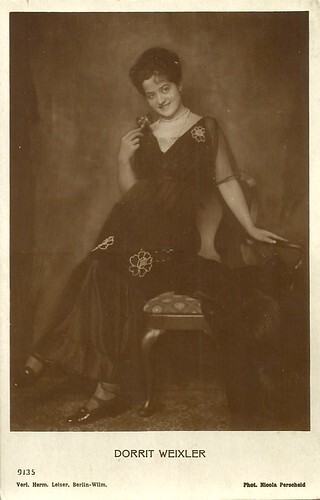
German postcard by Verlag Hermann Leiser, Berlin-Wilm., no. 9135. Photo: Nicola Perscheid.
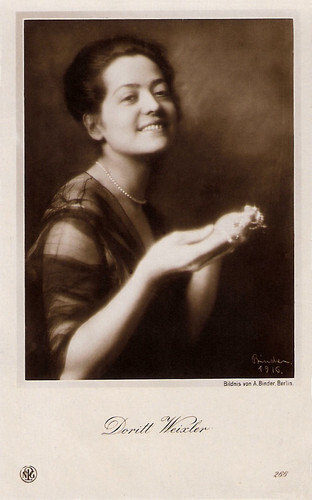
German postcard by NPG, no. 266. Photo: Alex Binder, 1916.
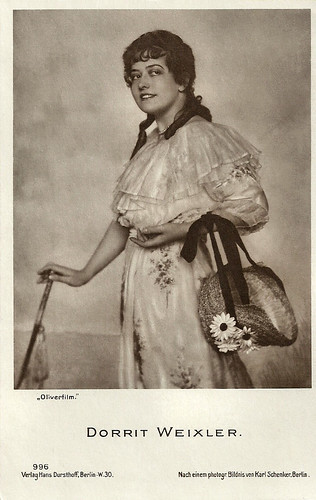
German postcard by Verlag Hans Dursthoff, Berlin, no. 996. Photo: Karl Schenker, Berlin / Oliver-Film.
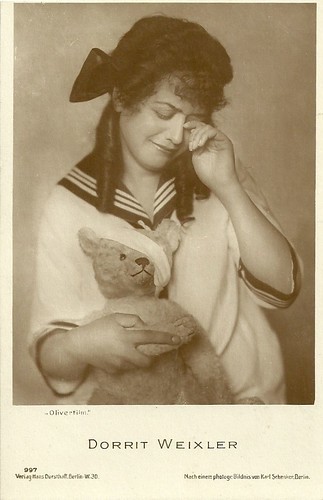
German postcard by Verlag Hans Dursthoff, Berlin, no. 997. Photo: Karl Schenker, Berlin / Oliver Film.
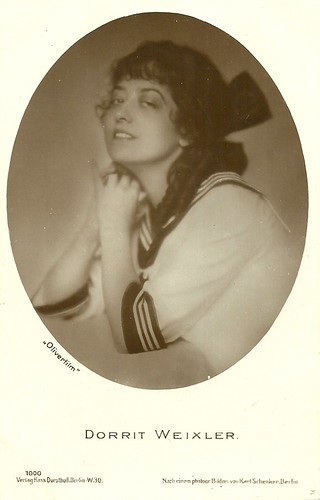
German postcard by Verlag Hans Dursthoff, Berlin, no. 1000. Photo: Karl Schenker, Berlin / Oliver Film.
Sources: André Stratmann (Stummfilmfan - German - no defunct), Thomas Staedeli (Cyranos), Wikipedia (German) and .

German postcard by Photochemie, Berlin, no. K. 1576.

German Postcard by Verlag Hermann Leiser, Berlin-Wilm, no. 7330.

German collectors card by Ross Verlag in the series Vom Werden Deutscher Filmkunst - Der Stumme Film, no. 45, group 43. Photo: Tobias-Film. Bruno Kastner , Dorrit Weixler and Frida Richard in Dorittchens Vergnügungsreise/Little Dorrit's Pleasure Trip (Paul Heidemann, 1916).

German postcard in the Moderne Künstler series by MMB, no. 455. Photo: F.J. Wesselsky.

German postcard in the Film-Sterne series by Rotophot, no. 75/2. Photo: Karl Schenker, Berlin / Oliver-Film.
Quicksilver
Dorrit Weixler was born in 1892. The actress Grete Weixler was her younger sister.
She first appeared in short films in 1911, like Seine erste Liebe/His First Love (Alwin Neuss, 1911) and Alwin auf der Hochzeitsreise/Alwin's Honeymoon Trip (Alwin Neuss, 1911), both featuring Alwin Neuss .
In 1913 she began a successful collaboration with silent film director-screenwriter Franz Hofer at the Luna Film studio. She had her breakthrough with Das rosa Pantöffelchen/The Pink Slipper (Franz Hofer, 1913) with Franz Schwaiger.
Hofer and Weixler would make ten films together such as Das Liebesbarometer/The Barometer of Love (Franz Hofer, 1914). In Ein verliebter Racker/A Rascal in Love (Franz Hofer, 1915) and Fraülein Piccolo/Miss piccolo (Franz Hofer, 1915) her film partner was the future film director Ernst Lubitsch . In Fraülein Piccolo she played a quicksilver waitress dressed up as a boy to push away the clients.
Other popular roles were the temperamental teenager or the tomboy in a sailor suit who is tamed by the 'right man'. During the First World War, Hofer directed her also in such patriotic war dramas as Deutsche Helden/German heroes (Franz Hofer, 1914) and Weihnachtsglöckchen/Christmas Bells (Franz Hofer, 1914).

German postcard by Verlag Hermann Leiser, Berlin-Wilm., no. 1550. Photo: Willinger.

German postcard in the Film-Sterne series by Rotophot, no. 75/3. Photo: Karl Schenker, Berlin / Oliver-Film, 3.

German postcard in the Film-Sterne series by Rotophot, no. 76/1. Photo: Karl Schenker, Berlin / Oliver-Film.

German postcard in the Film Sterne series by Rotophot, no. 76/5. Photo: Karl Schenker, Berlin.

German postcard in the Film Sterne series by Rotophot, no. 77/4. Photo: Karl Schenker, Berlin.
Stress
In 1915, Dorrit Weixler left Hofer and Luna Film to work for producer David Oliver at Oliver-Film, where she became the leading actress. Her type of roles stayed the same, and her directors Paul Otto and Paul Heidemann were often also her partners on screen.
The films were all about her and sometimes bore her name in the titles. Examples are Dorrits Chauffeur (Paul Otto, 1915) and Dorritts Vergnügungsreise/Dorritts pleasure trip (Paul Heidemann, 1916) opposite Bruno Kastner .
End of May 1916, she made her stage debut in the Theater am Nollendorfplatz in a 'Dorrit Weixler-week'. One night she collapsed on stage. Unfortunately the stress of turning out one film after another - over 20 films in two years - had been too much for Dorrit.
While trying to recover in a Berlin sanatorium, matters grew worse. She became dependent on morphine. In 1916, at the apex of her success, Dorrit Weixler committed suicide by hanging herself. She was only 24 years old.

German postcard by Verlag Hermann Leiser, Berlin-Wilm., no. 7325.

German postcard by Verlag Hermann Leiser, Berlin-Wilm., no. 9135. Photo: Nicola Perscheid.

German postcard by NPG, no. 266. Photo: Alex Binder, 1916.

German postcard by Verlag Hans Dursthoff, Berlin, no. 996. Photo: Karl Schenker, Berlin / Oliver-Film.

German postcard by Verlag Hans Dursthoff, Berlin, no. 997. Photo: Karl Schenker, Berlin / Oliver Film.

German postcard by Verlag Hans Dursthoff, Berlin, no. 1000. Photo: Karl Schenker, Berlin / Oliver Film.
Sources: André Stratmann (Stummfilmfan - German - no defunct), Thomas Staedeli (Cyranos), Wikipedia (German) and .
Published on April 25, 2022 22:00
April 24, 2022
VerzamelJaarbeurs 2022: Marlene’s treasures
On Saturday 9 and Sunday 10 April 2022, we could finally attend the VerzamelJaarbeurs again. The Jaarbeurs halls in the city of Utrecht were transformed into the largest collectors' fair in Europe. You can find pretty much everything you can collect, from vintage furniture, a huge collection of vinyl, toys from the past and present, games, stamps, and lots of other beautiful curiosities and articles. Marlene, Ivo, and I were there to look for interesting film postcards for EFSP. On Monday 11 April 2022, we presented the treasures I discovered in Utrecht and last Monday it was Ivo Blom's turn. Today it's time for the 15 treasures of Marlene Pilaete a.k.a. La Collectionneuse
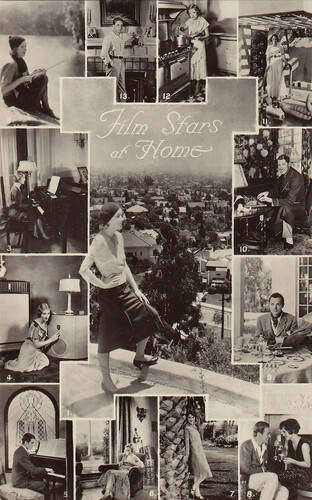
Dutch postcard by M. Bonnist & Zonen, Amsterdam. Caption: Film Stars at Home. The stars are 1: Anita Page, 2: Greta Garbo , 3: Jeanette MacDonald, 4: Elissa Landi , 5: Ramon Novarro , 6: Miriam Hopkins , 7: Janet Gaynor , 8: Joan Crawford and Douglas Fairbanks Jr. , 9: Robert Montgomery, 10: Maurice Chevalier , 11: Marlene Dietrich , 12: Marian Nixon, 13: Phillips Holmes.
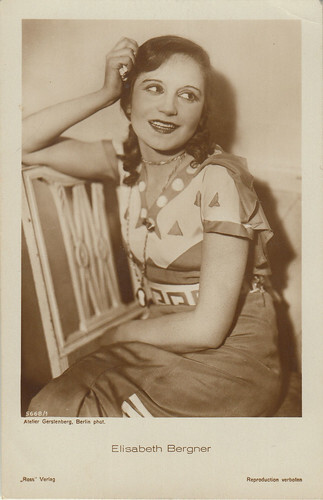
German postcard by Ross Verlag, no. 5668/1, 1930-1931. Photo: Atelier Gerstenberg, Berlin. Elisabeth Bergner .
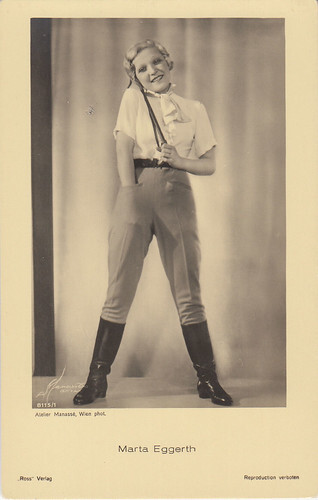
German postcard by Ross Verlag, no. 8115/1, 1933-1934. Photo: Atelier Manassé, Wien. Marta Eggerth .
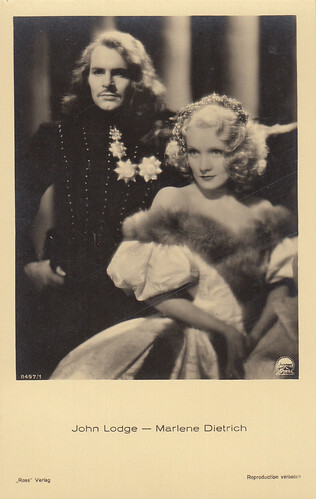
German postcard by Ross Verlag, no. 8497/1, 1933-1934. Photo: Paramount. John Lodge and Marlene Dietrich in The Scarlet Empress (Josef von Sternberg, 1934).
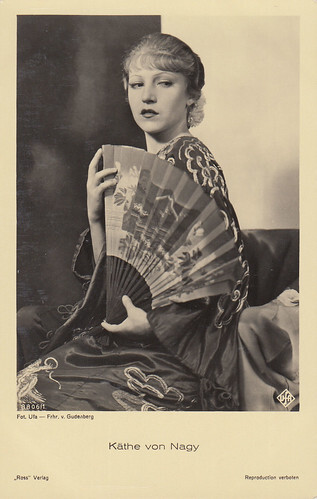
German postcard by Ross Verlag, no. 8806/1, 1933-1934. Photo: Ufa / Frhr. von Gudenberg. Käthe von Nagy .
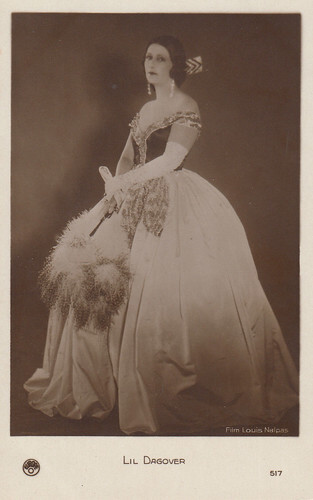
French postcard by Europe, no. 517. Photo: Louis Nalpas. Lil Dagover .
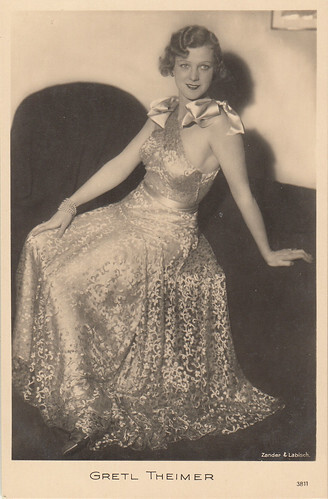
French postcard by Europe, no. 3811. Photo: Zander & Labisch. Gretl Theimer .
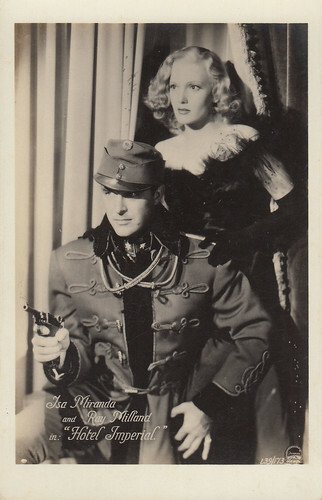
Postcard from the Dutch East Indies (now Indonesia), no. L39/173. Photo: Paramount. Isa Miranda and Ray Milland in Hotel Imperial (Robert Florey, 1939).
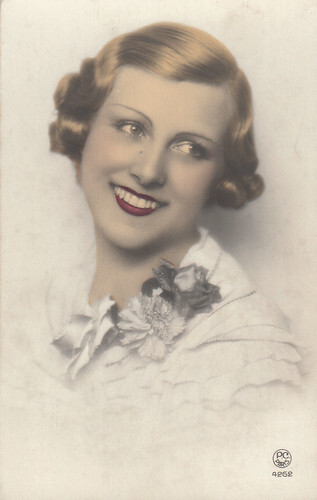
French postcard by P.C. Paris, no. 4262. Jeanne Helbling .
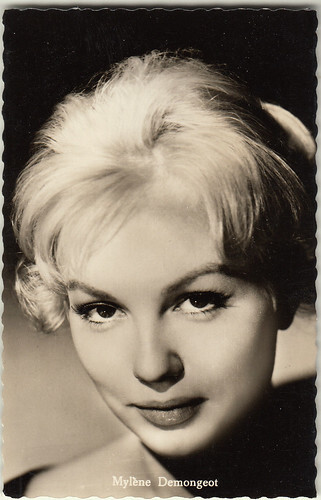
German postcard by Kolobri-Verlag G.m.b. H., no. 742. Mylène Demongeot .
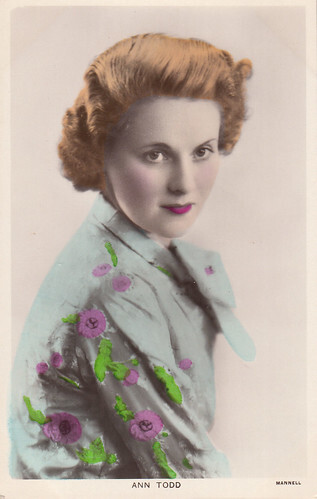
British postcard in the Colourgraph series, London, no. C219. Photo: Mannell. Ann Todd .
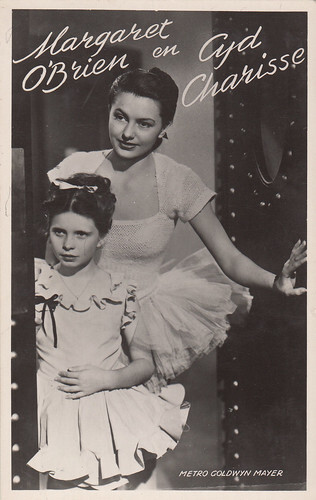
Dutch postcard by Takken, no. 3527. Photo: Metro Goldwyn Mayer. Margaret O'Brien and Cyd Charisse in The Unfinished Dance (Henry Koster, 1947).
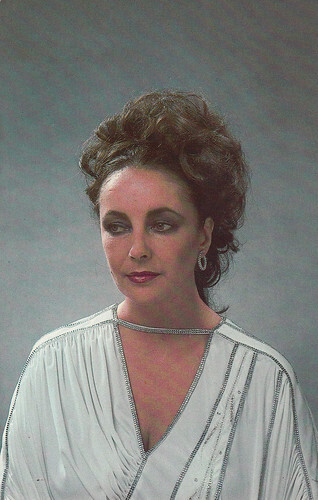
American postcard by Coral-Lee, Rancho Cordova, CA, no. 86. Elizabeth Taylor .
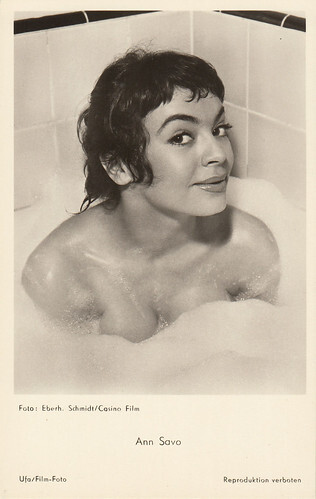
German postcard by Universum-Film Aktiengesellschaft (Ufa), Berlin Tempelhof. Photo: Eberhardt Schmidt / Casino Film. Ann Savo.
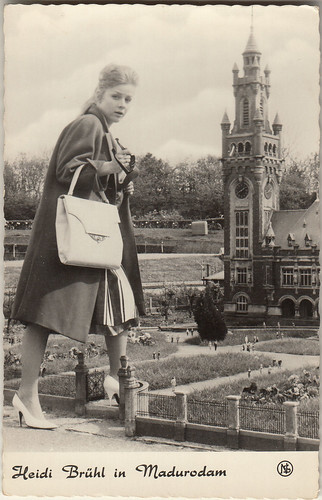
Dutch postcard by NS, no. 62119. Heidi Brühl in Madurodam.
A Dutch miniature city
Madurodam is a Dutch miniature city in The Hague on a scale of 1 to 25. This tourist attraction park opened on 2 July 1952 at George Maduro Square and attracts about 600,000 paying visitors annually. The miniature city has mostly served as an inspiration for the construction of several theme parks worldwide such as Legoland Billund and the Disneyland Park in Anaheim.
It is named after George Maduro, a Curaçao student who distinguished himself as a cavalry officer in the battle of the residence during the May days of 1940, and died in the Dachau concentration camp in February 1945. His parents donated the initial capital for the project, which is considered by the Maduro family as a monument to their only son.
Madurodam provides a picture of a Dutch city and Dutch society through over 700 scale models of buildings from all parts of the Netherlands. A hospital and a cemetery are missing. Some models move after inserting a coin into a coin machine. There are also interactive parts that the visitor can contribute to, such as the closing of the Oosterscheldekering or the loading of containers in the Rotterdam harbour. Some parts contain aural explanations about the things shown.
Madurodam is called a city, but it includes many miniature images of rural elements of the Netherlands. There are buildings from historic city centres, modern housing estates, port areas, an airport, canals, roads, farmland, nature reserves and more. It is a miniature city 'with a smile': many, sometimes comical, situations from everyday street life are depicted. Furthermore, there are many moving means of transport such as cars, canal boats, aeroplanes, trains and trams.
Source: Wikipedia (Dutch). Postcards: Collection Marlene Pilaete.

Dutch postcard by M. Bonnist & Zonen, Amsterdam. Caption: Film Stars at Home. The stars are 1: Anita Page, 2: Greta Garbo , 3: Jeanette MacDonald, 4: Elissa Landi , 5: Ramon Novarro , 6: Miriam Hopkins , 7: Janet Gaynor , 8: Joan Crawford and Douglas Fairbanks Jr. , 9: Robert Montgomery, 10: Maurice Chevalier , 11: Marlene Dietrich , 12: Marian Nixon, 13: Phillips Holmes.

German postcard by Ross Verlag, no. 5668/1, 1930-1931. Photo: Atelier Gerstenberg, Berlin. Elisabeth Bergner .

German postcard by Ross Verlag, no. 8115/1, 1933-1934. Photo: Atelier Manassé, Wien. Marta Eggerth .

German postcard by Ross Verlag, no. 8497/1, 1933-1934. Photo: Paramount. John Lodge and Marlene Dietrich in The Scarlet Empress (Josef von Sternberg, 1934).

German postcard by Ross Verlag, no. 8806/1, 1933-1934. Photo: Ufa / Frhr. von Gudenberg. Käthe von Nagy .

French postcard by Europe, no. 517. Photo: Louis Nalpas. Lil Dagover .

French postcard by Europe, no. 3811. Photo: Zander & Labisch. Gretl Theimer .

Postcard from the Dutch East Indies (now Indonesia), no. L39/173. Photo: Paramount. Isa Miranda and Ray Milland in Hotel Imperial (Robert Florey, 1939).

French postcard by P.C. Paris, no. 4262. Jeanne Helbling .

German postcard by Kolobri-Verlag G.m.b. H., no. 742. Mylène Demongeot .

British postcard in the Colourgraph series, London, no. C219. Photo: Mannell. Ann Todd .

Dutch postcard by Takken, no. 3527. Photo: Metro Goldwyn Mayer. Margaret O'Brien and Cyd Charisse in The Unfinished Dance (Henry Koster, 1947).

American postcard by Coral-Lee, Rancho Cordova, CA, no. 86. Elizabeth Taylor .

German postcard by Universum-Film Aktiengesellschaft (Ufa), Berlin Tempelhof. Photo: Eberhardt Schmidt / Casino Film. Ann Savo.

Dutch postcard by NS, no. 62119. Heidi Brühl in Madurodam.
A Dutch miniature city
Madurodam is a Dutch miniature city in The Hague on a scale of 1 to 25. This tourist attraction park opened on 2 July 1952 at George Maduro Square and attracts about 600,000 paying visitors annually. The miniature city has mostly served as an inspiration for the construction of several theme parks worldwide such as Legoland Billund and the Disneyland Park in Anaheim.
It is named after George Maduro, a Curaçao student who distinguished himself as a cavalry officer in the battle of the residence during the May days of 1940, and died in the Dachau concentration camp in February 1945. His parents donated the initial capital for the project, which is considered by the Maduro family as a monument to their only son.
Madurodam provides a picture of a Dutch city and Dutch society through over 700 scale models of buildings from all parts of the Netherlands. A hospital and a cemetery are missing. Some models move after inserting a coin into a coin machine. There are also interactive parts that the visitor can contribute to, such as the closing of the Oosterscheldekering or the loading of containers in the Rotterdam harbour. Some parts contain aural explanations about the things shown.
Madurodam is called a city, but it includes many miniature images of rural elements of the Netherlands. There are buildings from historic city centres, modern housing estates, port areas, an airport, canals, roads, farmland, nature reserves and more. It is a miniature city 'with a smile': many, sometimes comical, situations from everyday street life are depicted. Furthermore, there are many moving means of transport such as cars, canal boats, aeroplanes, trains and trams.
Source: Wikipedia (Dutch). Postcards: Collection Marlene Pilaete.
Published on April 24, 2022 22:00
April 23, 2022
Jacques Perrin (1941-2022)
On Thursday 21 April 2022, French actor Jacques Perrin (1941-2022) passed away. Handsome and talented, Perrin started his career as the romantic hero in the films of Italian director Valerio Zurlini. Later he made powerful films with Costa-Gravas and played the adult Salvatore in the international hit Cinema Paradiso (1988). With his own studio, he produced successful political films such as Z (1969) and nature documentaries such as Microcosmos (1996).

Spanish postcard by Archivo Bermejo, no. C-136, 1964. Photo: Radio Films. Jacques Perrin in La ragazza con la valigia/Girl with a Suitcase (Valerio Zurlini, 1961).

French postcard by E.D.U.G., Paris, no. 512. Photo: Sam Lévin.

French postcard by Editions d'art Yvon, Paris, no. 40-110-07. Photo: Parc Film / KIM. Micheline Presle and Jacques Perrin in Peau d'âne/Donkey Skin (Jacques Demy, 1970). Caption: Peau d'âne. Un Conte de Charles Perrault. Un film écrit et réalisé par Jacques Demi (sic). Ma mère, je désire que Peau d'Ane me fasse un gâteau. (Donkey Skin. A Tale by Charles Perrault. A film written and directed by Jacques Demi. My mother, I want Donkey Skin to make me a cake.)
Prince Charming
Jacques Perrin was born Jacques André Simonet in Paris in 1941. Occasionally, he is credited as Jacques Simonet. Perrin was his mother's name. His father, Alexandre Simonet, was a theatre director.
In 1946, the five years old made his uncredited film debut in Les Portes de la nuit/Gates of the Night (Marcel Carné, 1946), starring Serge Reggiani and Yves Montand . Perrin was trained as an actor at the Conservatoire National Supérieur d'Art Dramatique. On stage, he gave over 400 performances of L'Année du bac (Graduation Year) in a Paris theatre.
In the cinema, he played his first major juvenile parts in Italy for director Valerio Zurlini. He played Claudia Cardinale ’s boyfriend in the romantic comedy La Ragazza con la valigia/Girl with a Suitcase (Valerio Zurlini, 1961) and Marcello Mastroianni ’s younger brother in Cronaca familiar/Family Diary (Valerio Zurlini, 1962).
In France he acted with Brigitte Bardot in La Vérité/The Truth (Henri-Georges Clouzot, 1960), with Anna Karina in Le Soleil dans l'oeil/Sun in Your Eyes (Jacques Bourdon, 1962), and with Bruno Cremer in the war film La 317ème section/317th Platoon (Pierre Schoendoerffer, 1965).
He also worked on the thriller Compartiment tueurs/The Sleeping Car Murders (Costa-Gravas, 1965). James Travers at Films de France : "Costa-Gavras made his directoral debut with this fast-moving, convoluted but magnificently assembled crime thriller. The film reflects the director’s interest in American Film Noir and, thanks largely to an impressive cast, is one of his most entertaining films." It was the start of a long-time cooperation between actor and director.
In 1966, Perrin won two Best Actor awards at the Venice Film Festival or the Italian film Un uomo a metà/Almost a Man (Vittorio De Seta, 1966), and the Spanish film La busca/The Search (Angelino Fons, 1966). The next year, he co-starred in the musical Les demoiselles de Rochefort/The Young Girls of Rochefort (Jacques Demy, 1967) with Catherine Deneuve and Françoise Dorleac .
He would cooperate again with Demy and Deneuve on the fairytale Peau d'âne/Donkey Skin (Jacques Demy, 1970) in which he played an appealing Prince Charming. Craig Butler at AllMovie : “Donkey Skin is a strange but utterly captivating little fantasy and one that, despite its fairy tale origins, is really aimed more at adults than at children. Jacques Demy has directed with an eye toward whimsy, but whimsy mixed both with magic and subtle disorientation.”
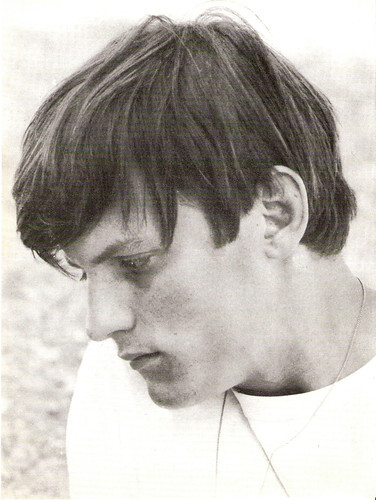
Spanish card by Romantica. Photo: Unifrance Films.
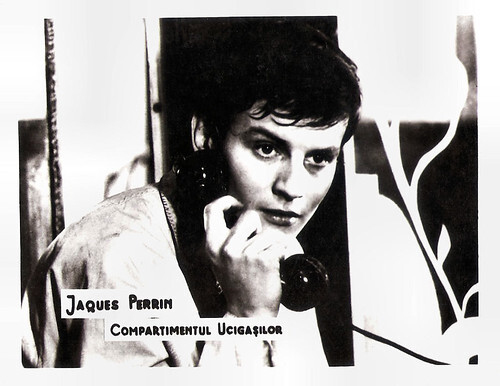
Small Romanian card by Cooperativa Fotografia, no. 13. Jacques Perrin in Compartiment tueurs/The Sleeping Car Murders (Costa Gravas, 1965).
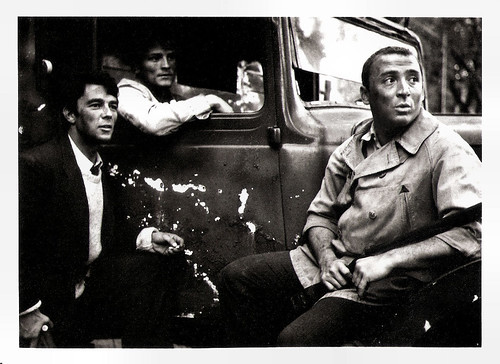
French postcard by Edition Librairie de la Fontaine, Paris, no. 141 (limited edition of 250 ex.). Photo: Claude Schwartz / Spadem. Gerard Blain , Jacques Perrin and Claude Brasseur in Un homme de trop/Shock Troops (Costa-Gravas, 1966).
Debts
At 27, Jacques Perrin created his own studio. He produced and acted in Z (1969), directed by Costa Gavras and starring Jean-Louis Trintignant , Yves Montand , and Irene Papas . The film presents a thinly fictionalized account of the events surrounding the assassination of democratic Greek politician Grigoris Lambrakis in 1963.
Dan Pavlides at AllMovie : “Z is one of the most politically insightful films ever made, exposing government hypocrisy and cover-up in the wake of a political assassination.” The production had nearly 4 million admissions in France and was the 4th highest-grossing film of the year. It was also the 10th highest-grossing film of 1969 in the United States. Z is also one of the few films to be nominated for both the Academy Award for Best Foreign Language Film and Best Picture.
Perrin worked with Costa-Gavras again on État de Siège/State of Siege (Costa-Gavras, 1972) and Section special/Special Section (Costa-Gavras, 1975). Both films had political themes, and Perrin continued this trend with La guerre d'Algérie/Algerian War (Yves Courrière, Philippe Monnier, 1975), a documentary on the Algerian uprising, and La Spirale/The Spiral (Armand Mattelart, Valérie Mayoux, Jacqueline Meppiel, 1976), a film on the Chilean presidency of Salvador Allende.
In 1976, Perrin produced another Oscar-winning film, La Victoire en chantant/Black and White in Color (Jean-Jacques Annaud, 1976). That year, he also embarked on Il deserto dei Tartari/Le Désert des Tartares/The Desert of the Tartars (Valerio Zurlini, 1976), with a cast filled with such big-name actors as Jean-Louis Trintignant , Vittorio Gassman , Max von Sydow, Francisco Rabal , Helmut Griem , Giuliano Gemma , Philippe Noiret , Fernando Rey, and Laurent Terzieff .
The film, based on Dino Buzzati's novel The Tartar Steppe, tells the story of a young officer, Giovanni Drogo (Jacques Perrin), and the time that he spent guarding the Bastiani Fortress, an old, unmaintained border fortress. Although the film won the Grand Prix du Cinéma Français and three David di Donatello Awards in 1977, it was not very successful and left Perrin with debts.
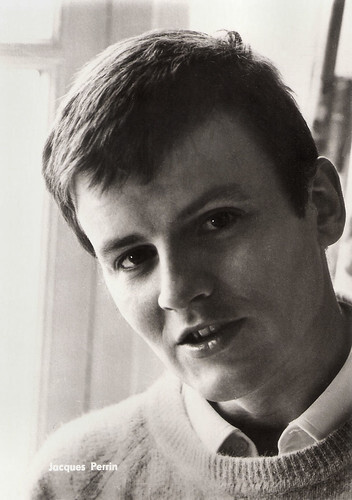
East-German postcard by VEB Progress Filmvertrieb, Berlin, no. 3263, 1963.
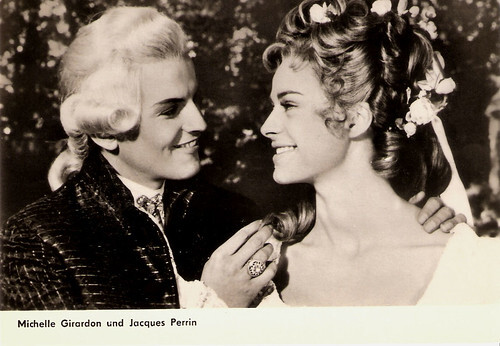
East-German postcard by VEB Progress Filvertrieb, Berlin, no. 3143, 1968. Retail price: 0,20 M. Photo: publicity still for Rose rosse per Angelica/Red Roses for Angelica (Steno, 1968) with Michelle Girardon.
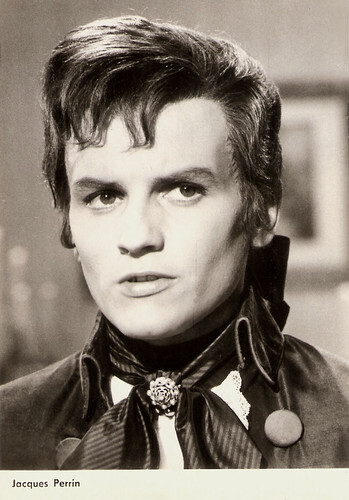
East-German postcard by VEB Progress Filvertrieb, Berlin, no. 3144, 1968. Retail price: 0,20 M. Photo: publicity still for Rose rosse per Angelica/Red Roses for Angelica (Steno, 1968).
An astoundingly intimate glimpse
Jacques Perrin had a huge success with the Italian drama Nuovo Cinema Paradiso/Cinema Paradiso (Giuseppe Tornatore, 1988). He played a famous film director who remembers his childhood at the Cinema Paradiso where Alfredo, the projectionist ( Philippe Noiret ), first brought about his love of films. Cinema Paradiso was a critical and box-office success and won many awards including the Golden Globe, the BAFTA and the Oscar for Best Foreign Film.
Two years later, he also appeared in Tornatore’s Stanno tutti bene/Everybody’s Fine (Giuseppe Tornatore, 1990) starring Marcello Mastroianni . As a producer, Perrin changed direction when he decided that the natural life around us could tell stories as fascinating and varied as anything dreamt up by a scriptwriter.
He produced nature documentaries that transformed the scope of wildlife films, from Microcosmos (Claude Nuridsany, Marie Pérennou, 1996), in which ants performed the starring role, to the austere travelogue Himalaya (Eric Valli, 1999), nominated for an Oscar, and Le Peuple Migrateur/Winged Migration (Jacques Cluzaud, Michel Debats, Jacques Perrin, 2001), which followed some 50 species of birds across 30 countries.
All were filmed by Perrin’s studio Galatée Films. Another successful production was Les choristes/The Chorus (Christophe Barratier, 2004). In this drama, Perrin played the narrator, the old orchestra conductor Pierre Morhange, who reminisces about his childhood inspirations through the pages of a diary kept by his old music teacher. The young Pépinot was played by Perrin’s son Maxence. Other films in which he played were the historical horror film Le pacte des loups/Brotherhood of the Wolf (Christophe Gans, 2001), and the crime drama Le petit lieutenant/The Young Lieutenant (Xavier Beauvois, 2005) with Nathalie Baye.
He also directed the film Océans/Oceans (Jacques Perrin, Jacques Cluzaud, 2009). Tracie Cooper at AllMovie : "Narrated by Pierce Brosnan , Oceans is made up of a compilation of underwater photography from over 75 diving expeditions that took place over a period of four years, and captures an astoundingly intimate glimpse into the lives of a wide array of sea life." In the following decade, he continued to make beautiful documentaries on what binds mankind and nature, including Les saisons/The Seasons (Jacques Perrin, Alexandre Poulichot, Jacques Cluzaud, 2015).
In 1985, Jacques Perrin was made Knight of the Ordre national du Mérite, in 1997 he was promoted to Officer and in 2003 to Commander. He was also made Knight of the Légion d'honneur in 1990 and promoted to Officer in 2007. Perrin remained active till his death. He played the old Rémi in Rémi sans famille/Remi, Nobody's Boy (Antoine Blossier, 2018) opposite Daniel Auteuil and Virginie Ledoyen and his final film role was in the thriller Goliath (Frédéric Tellier, 2022). On 21 April 2022, he passed away in Paris at the age of 80. Jacques Perrin had three sons, actor Mathieu Perrin (1975), actor Maxence Perrin (1995), and Lancelot Perrin (2000).
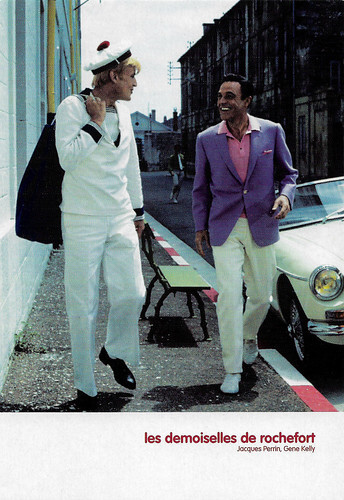
French postcard by CartCom & Com for the DVD release pf 'Integrale Jacques Demy' by Ciné-Tamaris and Arte Video, 1996. Photo: H. Jeanbrau. Jacques Perrin and Gene Kelly in Les demoiselles de Rochefort (Jacques Demy, 1967).
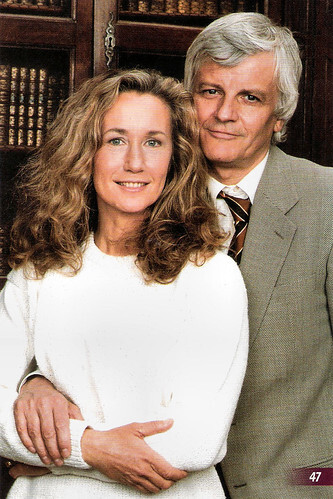
French postcard by Editions Atlas, Evreux, no. 47. Photo: Jacques Morell / Kipa / Corbis. Brigitte Fossey and Jacques Perrin in Le Château des Oliviers/The Oliviers Castle (Nicholas Gessner, 1993).
Trailer for Z (1969). Source: VegetativeHorse (YouTube).
Trailer for Océans/Oceans (2009). Source: IulianG (YouTube).
Sources: James Travers (Films de France), Craig Butler (AllMovie), Dan Pavlides (AllMovie), Tracie Cooper (AllMovie), John Whitley (The Telegraph), Wikipedia, and .

Spanish postcard by Archivo Bermejo, no. C-136, 1964. Photo: Radio Films. Jacques Perrin in La ragazza con la valigia/Girl with a Suitcase (Valerio Zurlini, 1961).

French postcard by E.D.U.G., Paris, no. 512. Photo: Sam Lévin.

French postcard by Editions d'art Yvon, Paris, no. 40-110-07. Photo: Parc Film / KIM. Micheline Presle and Jacques Perrin in Peau d'âne/Donkey Skin (Jacques Demy, 1970). Caption: Peau d'âne. Un Conte de Charles Perrault. Un film écrit et réalisé par Jacques Demi (sic). Ma mère, je désire que Peau d'Ane me fasse un gâteau. (Donkey Skin. A Tale by Charles Perrault. A film written and directed by Jacques Demi. My mother, I want Donkey Skin to make me a cake.)
Prince Charming
Jacques Perrin was born Jacques André Simonet in Paris in 1941. Occasionally, he is credited as Jacques Simonet. Perrin was his mother's name. His father, Alexandre Simonet, was a theatre director.
In 1946, the five years old made his uncredited film debut in Les Portes de la nuit/Gates of the Night (Marcel Carné, 1946), starring Serge Reggiani and Yves Montand . Perrin was trained as an actor at the Conservatoire National Supérieur d'Art Dramatique. On stage, he gave over 400 performances of L'Année du bac (Graduation Year) in a Paris theatre.
In the cinema, he played his first major juvenile parts in Italy for director Valerio Zurlini. He played Claudia Cardinale ’s boyfriend in the romantic comedy La Ragazza con la valigia/Girl with a Suitcase (Valerio Zurlini, 1961) and Marcello Mastroianni ’s younger brother in Cronaca familiar/Family Diary (Valerio Zurlini, 1962).
In France he acted with Brigitte Bardot in La Vérité/The Truth (Henri-Georges Clouzot, 1960), with Anna Karina in Le Soleil dans l'oeil/Sun in Your Eyes (Jacques Bourdon, 1962), and with Bruno Cremer in the war film La 317ème section/317th Platoon (Pierre Schoendoerffer, 1965).
He also worked on the thriller Compartiment tueurs/The Sleeping Car Murders (Costa-Gravas, 1965). James Travers at Films de France : "Costa-Gavras made his directoral debut with this fast-moving, convoluted but magnificently assembled crime thriller. The film reflects the director’s interest in American Film Noir and, thanks largely to an impressive cast, is one of his most entertaining films." It was the start of a long-time cooperation between actor and director.
In 1966, Perrin won two Best Actor awards at the Venice Film Festival or the Italian film Un uomo a metà/Almost a Man (Vittorio De Seta, 1966), and the Spanish film La busca/The Search (Angelino Fons, 1966). The next year, he co-starred in the musical Les demoiselles de Rochefort/The Young Girls of Rochefort (Jacques Demy, 1967) with Catherine Deneuve and Françoise Dorleac .
He would cooperate again with Demy and Deneuve on the fairytale Peau d'âne/Donkey Skin (Jacques Demy, 1970) in which he played an appealing Prince Charming. Craig Butler at AllMovie : “Donkey Skin is a strange but utterly captivating little fantasy and one that, despite its fairy tale origins, is really aimed more at adults than at children. Jacques Demy has directed with an eye toward whimsy, but whimsy mixed both with magic and subtle disorientation.”

Spanish card by Romantica. Photo: Unifrance Films.

Small Romanian card by Cooperativa Fotografia, no. 13. Jacques Perrin in Compartiment tueurs/The Sleeping Car Murders (Costa Gravas, 1965).

French postcard by Edition Librairie de la Fontaine, Paris, no. 141 (limited edition of 250 ex.). Photo: Claude Schwartz / Spadem. Gerard Blain , Jacques Perrin and Claude Brasseur in Un homme de trop/Shock Troops (Costa-Gravas, 1966).
Debts
At 27, Jacques Perrin created his own studio. He produced and acted in Z (1969), directed by Costa Gavras and starring Jean-Louis Trintignant , Yves Montand , and Irene Papas . The film presents a thinly fictionalized account of the events surrounding the assassination of democratic Greek politician Grigoris Lambrakis in 1963.
Dan Pavlides at AllMovie : “Z is one of the most politically insightful films ever made, exposing government hypocrisy and cover-up in the wake of a political assassination.” The production had nearly 4 million admissions in France and was the 4th highest-grossing film of the year. It was also the 10th highest-grossing film of 1969 in the United States. Z is also one of the few films to be nominated for both the Academy Award for Best Foreign Language Film and Best Picture.
Perrin worked with Costa-Gavras again on État de Siège/State of Siege (Costa-Gavras, 1972) and Section special/Special Section (Costa-Gavras, 1975). Both films had political themes, and Perrin continued this trend with La guerre d'Algérie/Algerian War (Yves Courrière, Philippe Monnier, 1975), a documentary on the Algerian uprising, and La Spirale/The Spiral (Armand Mattelart, Valérie Mayoux, Jacqueline Meppiel, 1976), a film on the Chilean presidency of Salvador Allende.
In 1976, Perrin produced another Oscar-winning film, La Victoire en chantant/Black and White in Color (Jean-Jacques Annaud, 1976). That year, he also embarked on Il deserto dei Tartari/Le Désert des Tartares/The Desert of the Tartars (Valerio Zurlini, 1976), with a cast filled with such big-name actors as Jean-Louis Trintignant , Vittorio Gassman , Max von Sydow, Francisco Rabal , Helmut Griem , Giuliano Gemma , Philippe Noiret , Fernando Rey, and Laurent Terzieff .
The film, based on Dino Buzzati's novel The Tartar Steppe, tells the story of a young officer, Giovanni Drogo (Jacques Perrin), and the time that he spent guarding the Bastiani Fortress, an old, unmaintained border fortress. Although the film won the Grand Prix du Cinéma Français and three David di Donatello Awards in 1977, it was not very successful and left Perrin with debts.

East-German postcard by VEB Progress Filmvertrieb, Berlin, no. 3263, 1963.

East-German postcard by VEB Progress Filvertrieb, Berlin, no. 3143, 1968. Retail price: 0,20 M. Photo: publicity still for Rose rosse per Angelica/Red Roses for Angelica (Steno, 1968) with Michelle Girardon.

East-German postcard by VEB Progress Filvertrieb, Berlin, no. 3144, 1968. Retail price: 0,20 M. Photo: publicity still for Rose rosse per Angelica/Red Roses for Angelica (Steno, 1968).
An astoundingly intimate glimpse
Jacques Perrin had a huge success with the Italian drama Nuovo Cinema Paradiso/Cinema Paradiso (Giuseppe Tornatore, 1988). He played a famous film director who remembers his childhood at the Cinema Paradiso where Alfredo, the projectionist ( Philippe Noiret ), first brought about his love of films. Cinema Paradiso was a critical and box-office success and won many awards including the Golden Globe, the BAFTA and the Oscar for Best Foreign Film.
Two years later, he also appeared in Tornatore’s Stanno tutti bene/Everybody’s Fine (Giuseppe Tornatore, 1990) starring Marcello Mastroianni . As a producer, Perrin changed direction when he decided that the natural life around us could tell stories as fascinating and varied as anything dreamt up by a scriptwriter.
He produced nature documentaries that transformed the scope of wildlife films, from Microcosmos (Claude Nuridsany, Marie Pérennou, 1996), in which ants performed the starring role, to the austere travelogue Himalaya (Eric Valli, 1999), nominated for an Oscar, and Le Peuple Migrateur/Winged Migration (Jacques Cluzaud, Michel Debats, Jacques Perrin, 2001), which followed some 50 species of birds across 30 countries.
All were filmed by Perrin’s studio Galatée Films. Another successful production was Les choristes/The Chorus (Christophe Barratier, 2004). In this drama, Perrin played the narrator, the old orchestra conductor Pierre Morhange, who reminisces about his childhood inspirations through the pages of a diary kept by his old music teacher. The young Pépinot was played by Perrin’s son Maxence. Other films in which he played were the historical horror film Le pacte des loups/Brotherhood of the Wolf (Christophe Gans, 2001), and the crime drama Le petit lieutenant/The Young Lieutenant (Xavier Beauvois, 2005) with Nathalie Baye.
He also directed the film Océans/Oceans (Jacques Perrin, Jacques Cluzaud, 2009). Tracie Cooper at AllMovie : "Narrated by Pierce Brosnan , Oceans is made up of a compilation of underwater photography from over 75 diving expeditions that took place over a period of four years, and captures an astoundingly intimate glimpse into the lives of a wide array of sea life." In the following decade, he continued to make beautiful documentaries on what binds mankind and nature, including Les saisons/The Seasons (Jacques Perrin, Alexandre Poulichot, Jacques Cluzaud, 2015).
In 1985, Jacques Perrin was made Knight of the Ordre national du Mérite, in 1997 he was promoted to Officer and in 2003 to Commander. He was also made Knight of the Légion d'honneur in 1990 and promoted to Officer in 2007. Perrin remained active till his death. He played the old Rémi in Rémi sans famille/Remi, Nobody's Boy (Antoine Blossier, 2018) opposite Daniel Auteuil and Virginie Ledoyen and his final film role was in the thriller Goliath (Frédéric Tellier, 2022). On 21 April 2022, he passed away in Paris at the age of 80. Jacques Perrin had three sons, actor Mathieu Perrin (1975), actor Maxence Perrin (1995), and Lancelot Perrin (2000).

French postcard by CartCom & Com for the DVD release pf 'Integrale Jacques Demy' by Ciné-Tamaris and Arte Video, 1996. Photo: H. Jeanbrau. Jacques Perrin and Gene Kelly in Les demoiselles de Rochefort (Jacques Demy, 1967).

French postcard by Editions Atlas, Evreux, no. 47. Photo: Jacques Morell / Kipa / Corbis. Brigitte Fossey and Jacques Perrin in Le Château des Oliviers/The Oliviers Castle (Nicholas Gessner, 1993).
Trailer for Z (1969). Source: VegetativeHorse (YouTube).
Trailer for Océans/Oceans (2009). Source: IulianG (YouTube).
Sources: James Travers (Films de France), Craig Butler (AllMovie), Dan Pavlides (AllMovie), Tracie Cooper (AllMovie), John Whitley (The Telegraph), Wikipedia, and .
Published on April 23, 2022 22:00
Paul van Yperen's Blog
- Paul van Yperen's profile
- 13 followers
Paul van Yperen isn't a Goodreads Author
(yet),
but they
do have a blog,
so here are some recent posts imported from
their feed.



